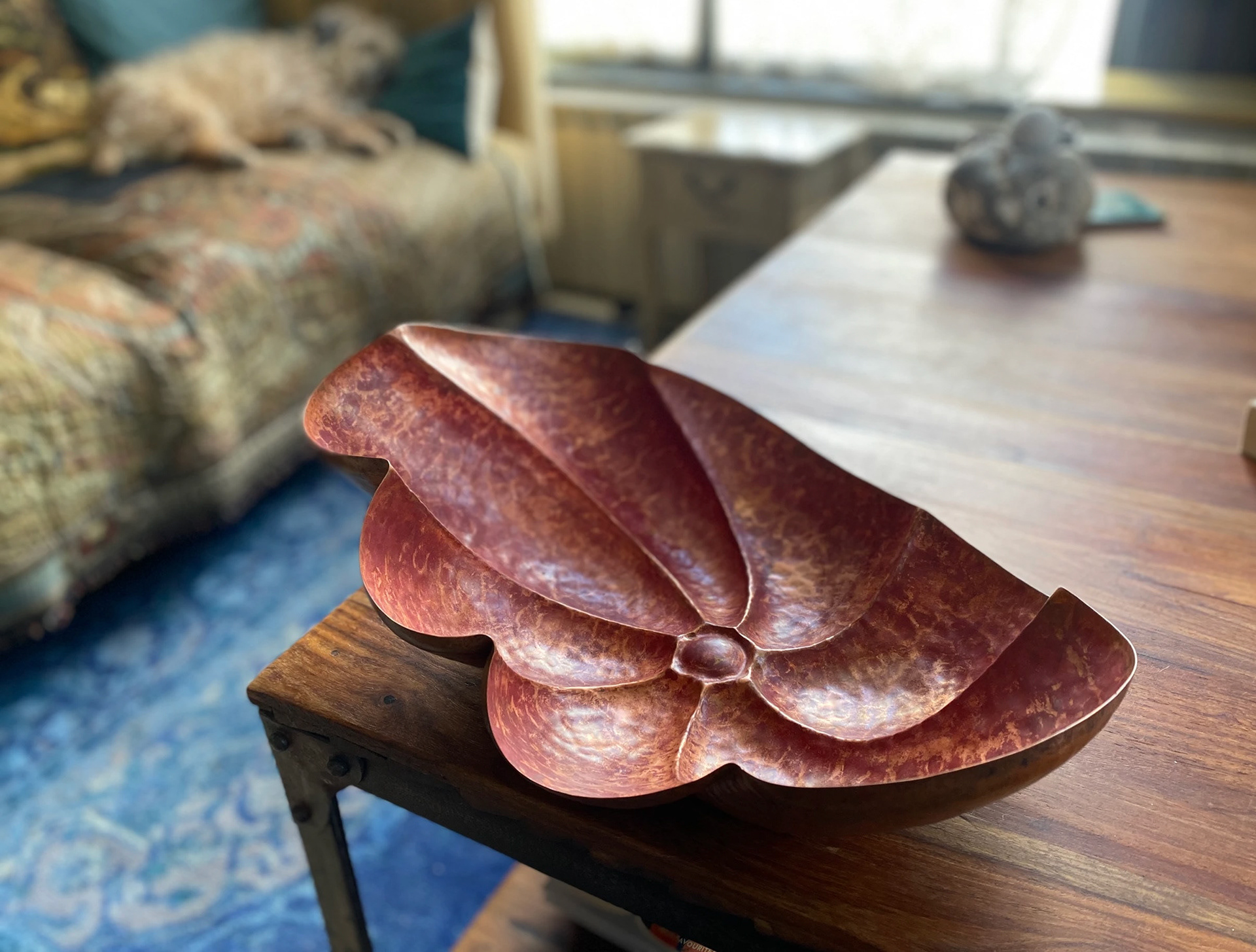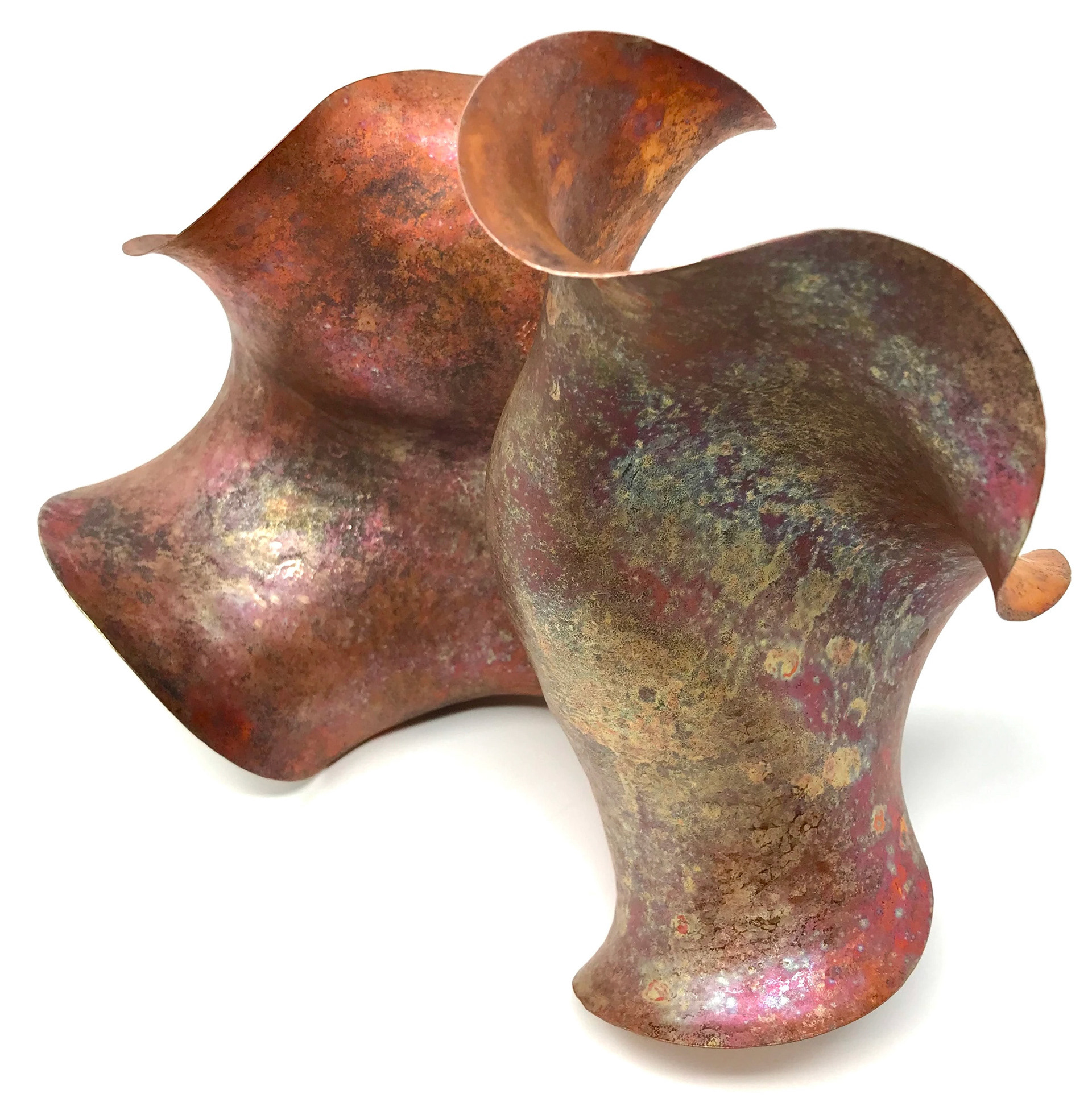Summer Patina Exploration:
Over the summer, I started researching artificial Patinas and the different home remedies. The image bellow shows the initial research I did on patinas. The first tests didn’t work out very well, however I learnt a lot from them and allowed me to continue to improve this technique.
I looked into application techniques, sealants, and chemicals that go into the production of a patina. This page is a log of my planning and research done on patinas and how I managed to achieve the best effects. (The results of these tests can be found on my Beta Project Page)
Further Patina Research:
For my CP3 I did a lot of extensive research on the chemical processes that occur on natural patinas. For the purposes of my project, I focused on copper and copper alloys like bronze as this is the material I am using for this project. From this research I deduced that the process of creating a patina starts with the surface layer of the copper reacting with oxygen in the air. This surface layer turns into a compound called cuprous oxide. The next step occurs when the cuprous oxide reacts with other elements present in the soil to produce a copper salt which gives the patina different colours. The salts demonstrated in my CP3 explain how these will be my colour pallet for the rest of the project and I will try to recreate these natural patinas in an artificial way using chemicals. The most common salts can be seen bellow:
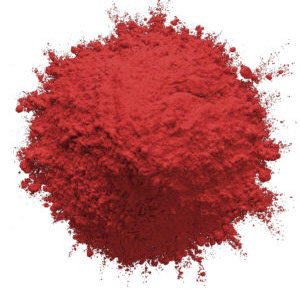
Cuprous Oxide
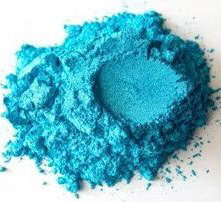
Copper Phosphate
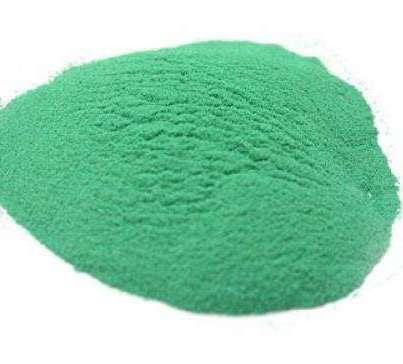
Copper Carbonate
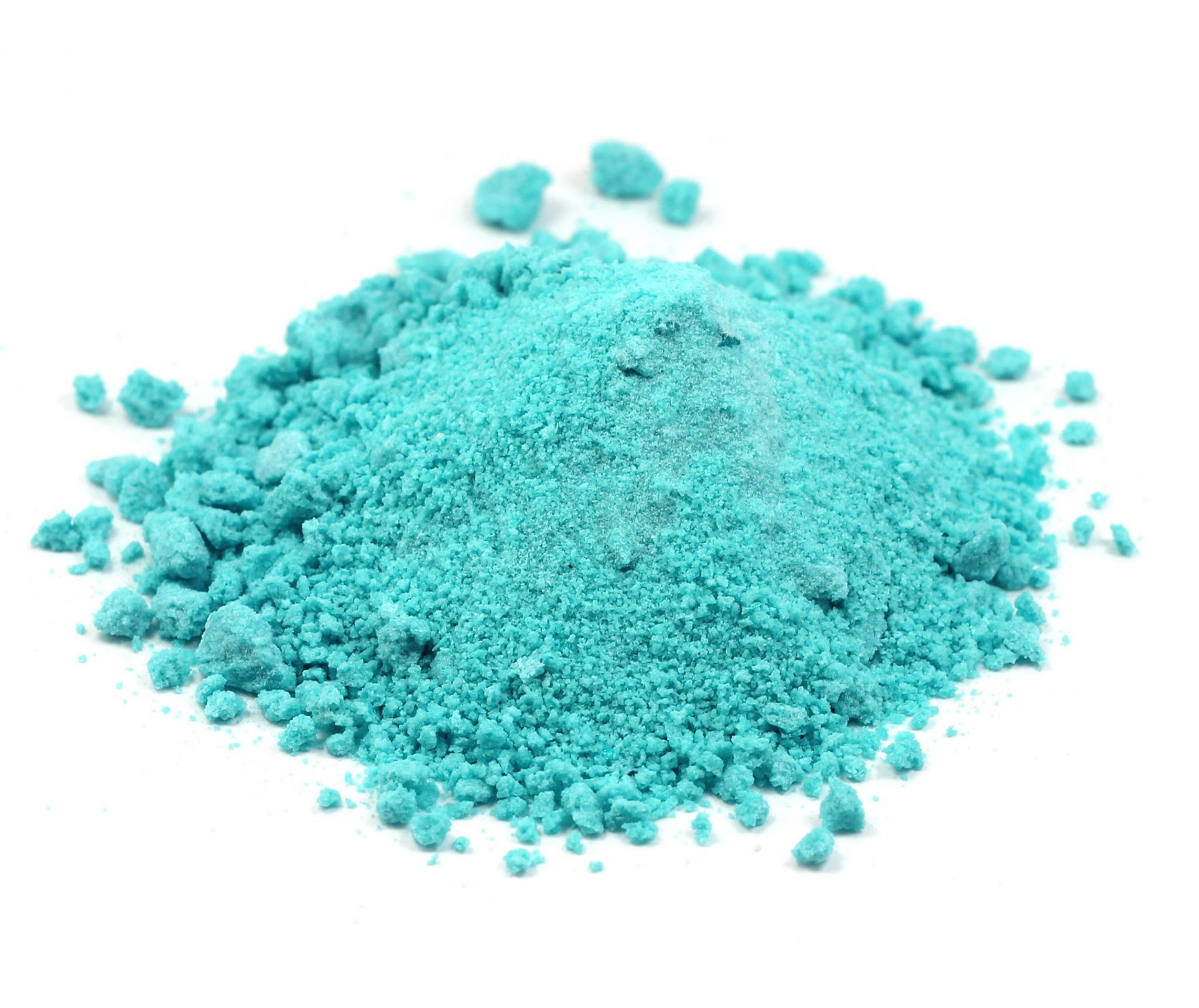
Copper Chloride
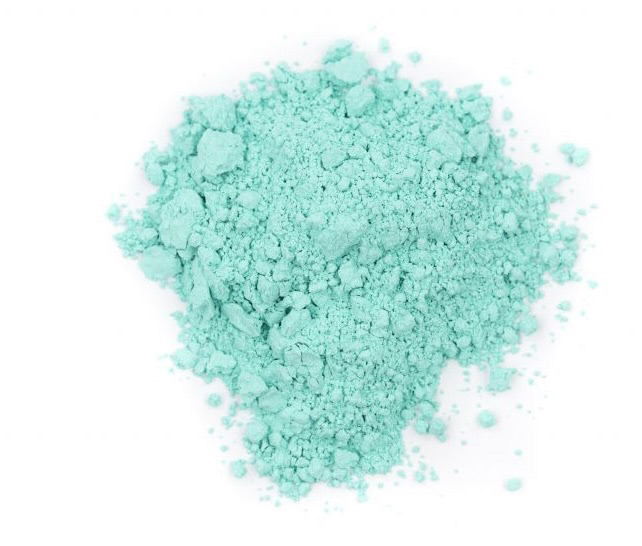
Copper Silicate
If you would like to know more about the research I conduced on patination you can find it a section of my CP3 essay:
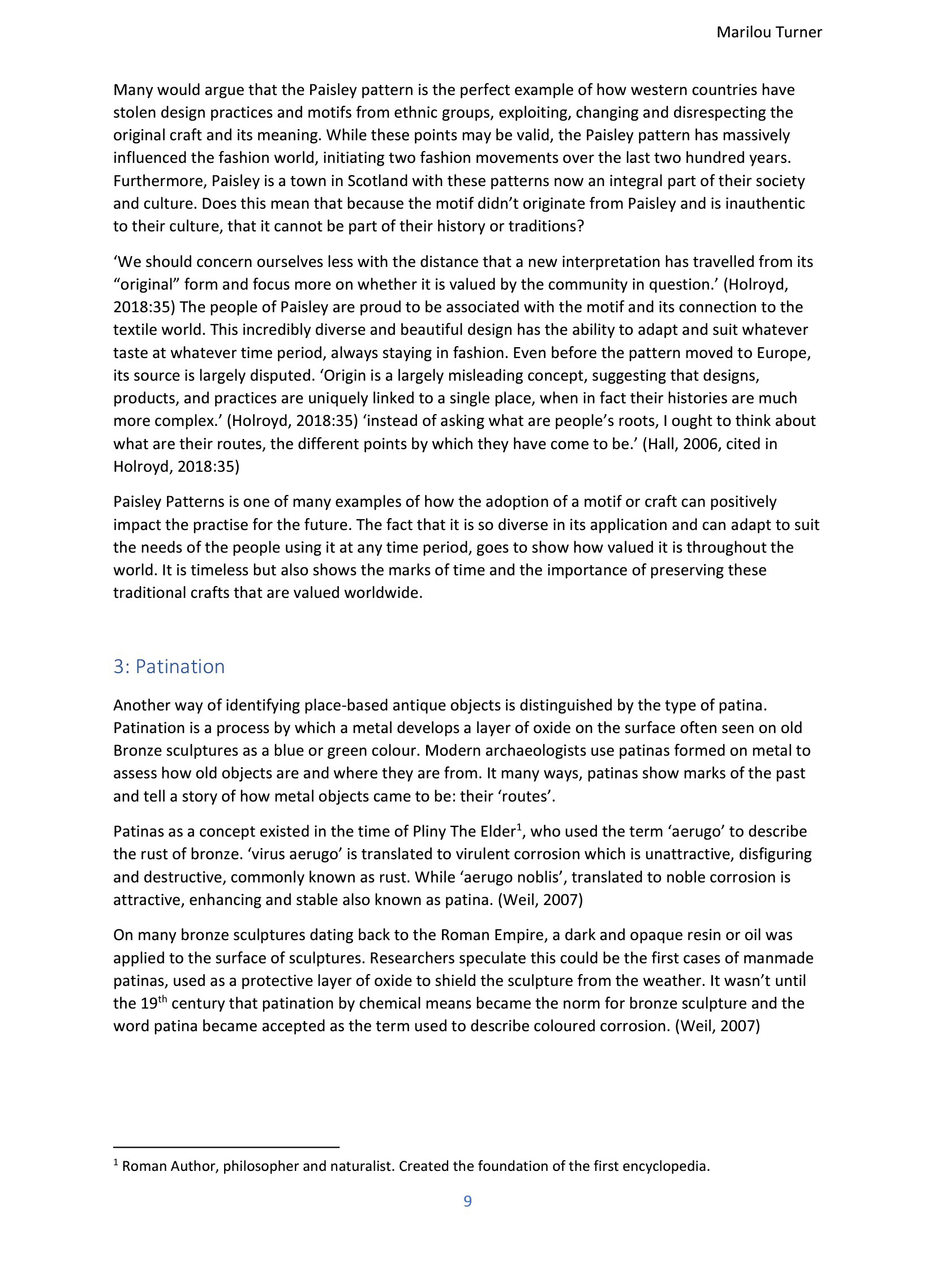
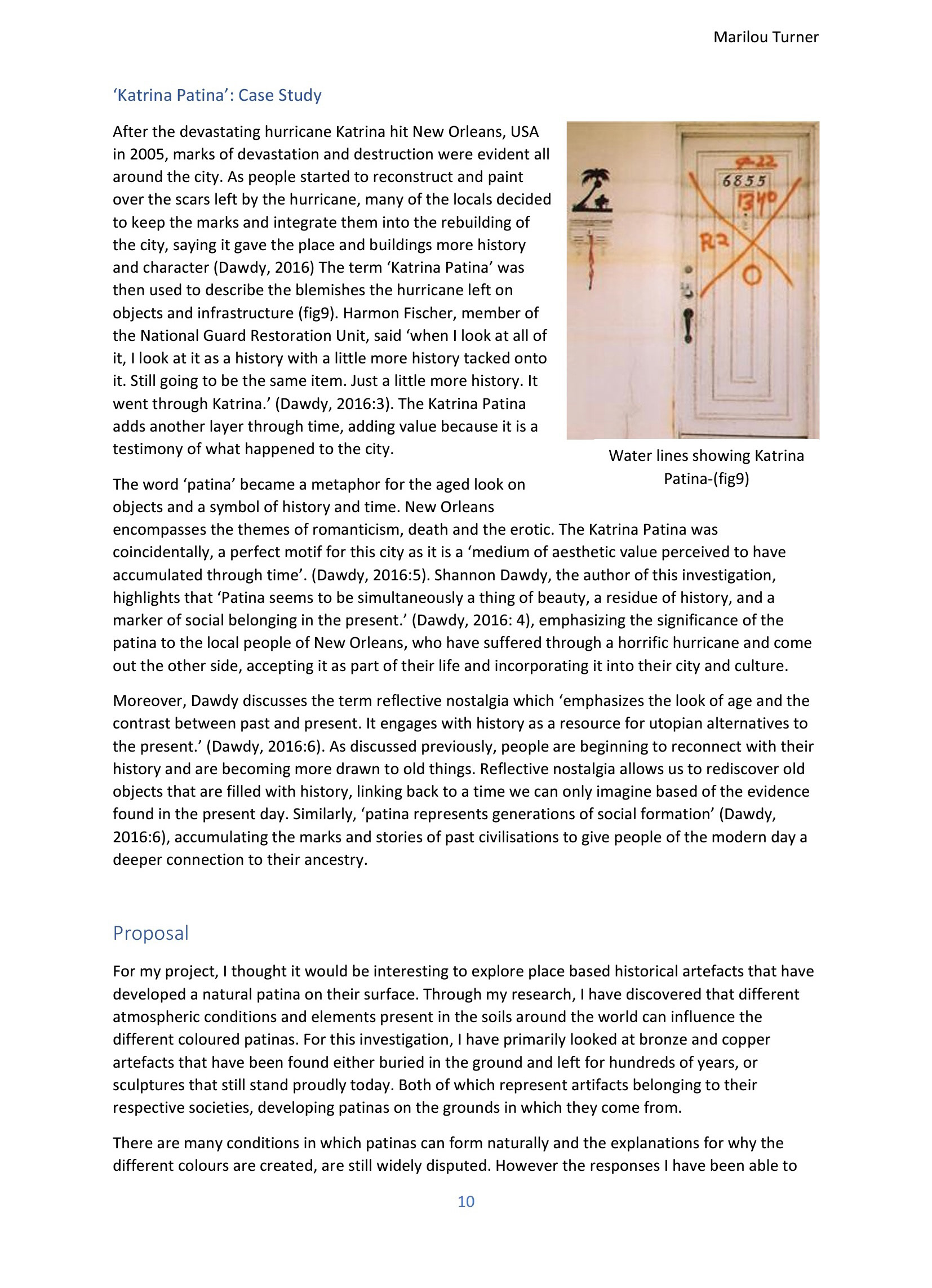
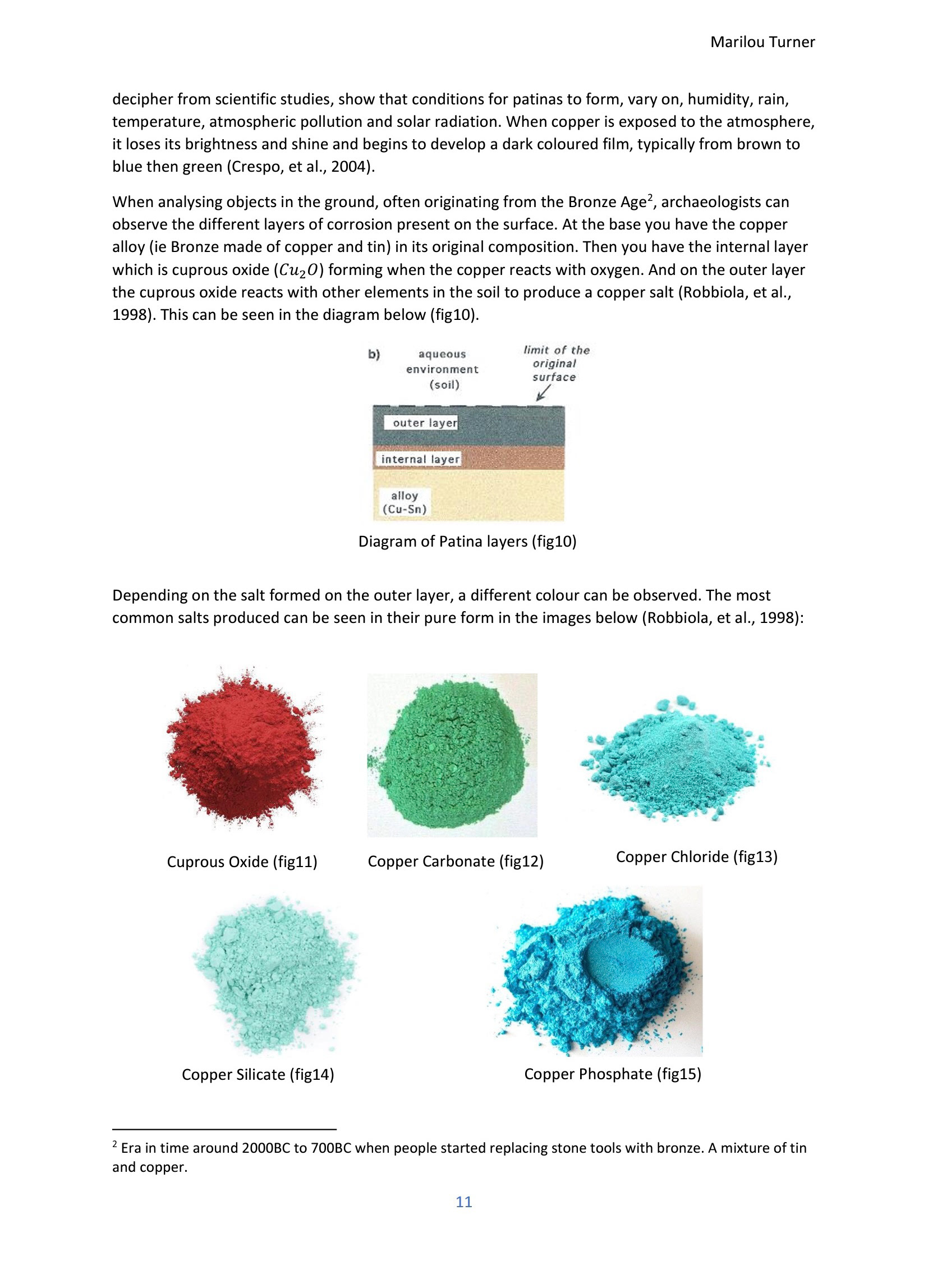
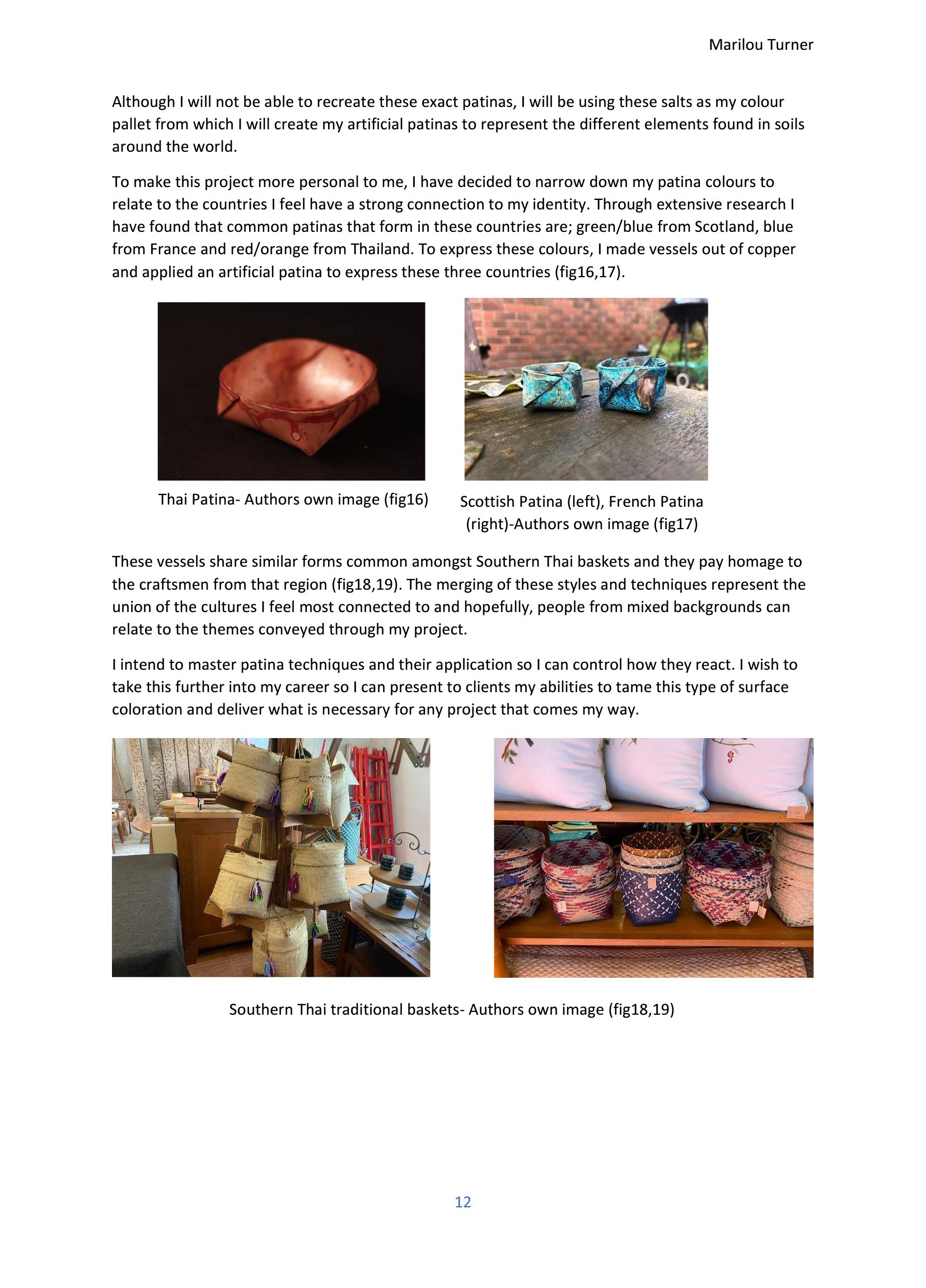
Cup & Bowl exploration:
I wanted to see how I could explore patination on 3D objects, so i decided to do some research into cups & bowls from around the world to see how their forms and shapes differ from each other. These forms influenced the designs of my cups/boxes for my project.
As part of my CP3 I conducted an interview at Paya Shop in Bangkok and the objects in the shop are from all across Thailand. These products helped my design for my boxes as I have always tried to take influence from Thai designs in my work. the traditional crafts sold here are beautiful and filled with history and tradition. The images bellow show a range of different crafts from ceramics, to basketry, and woodworking.
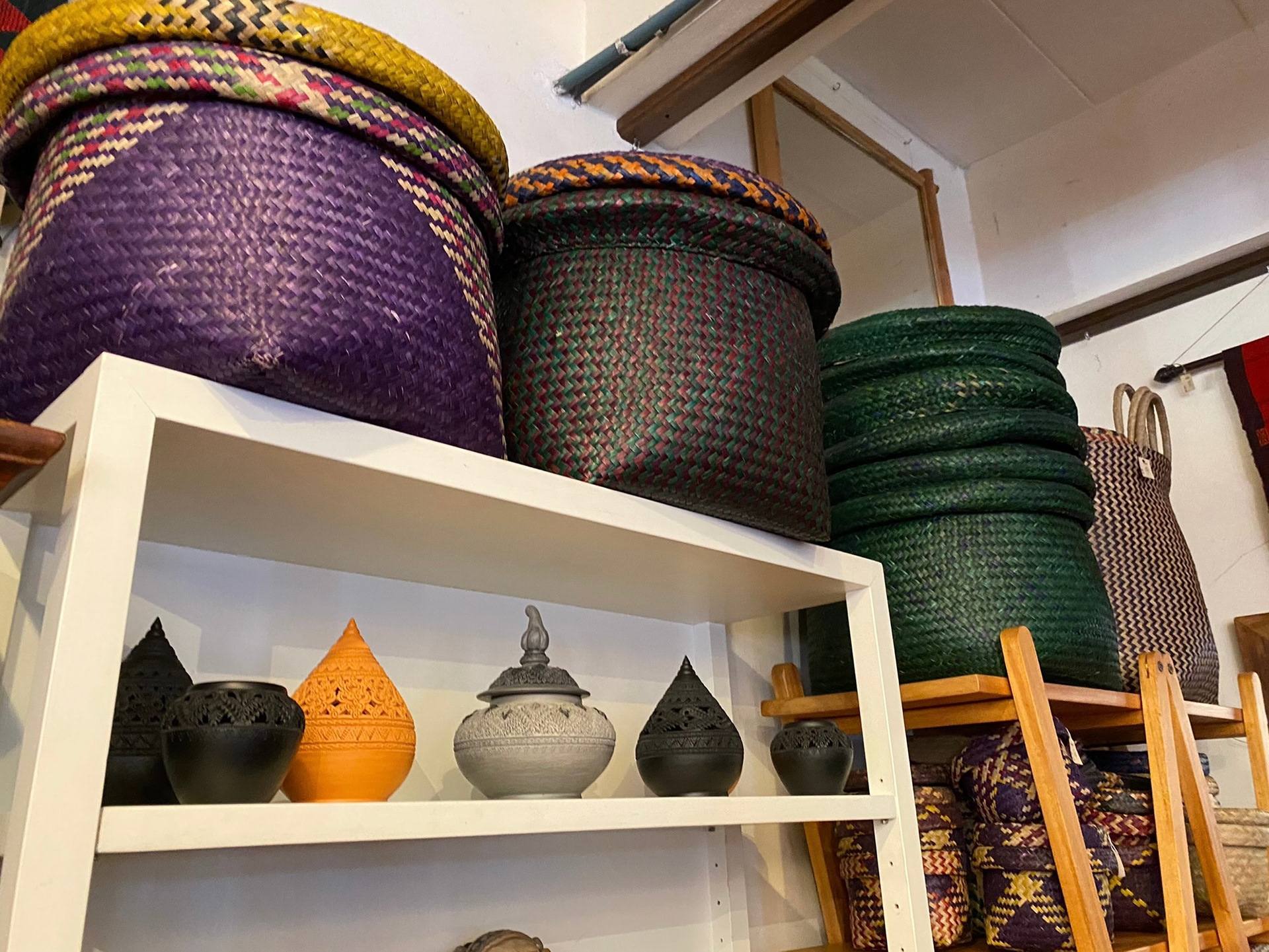
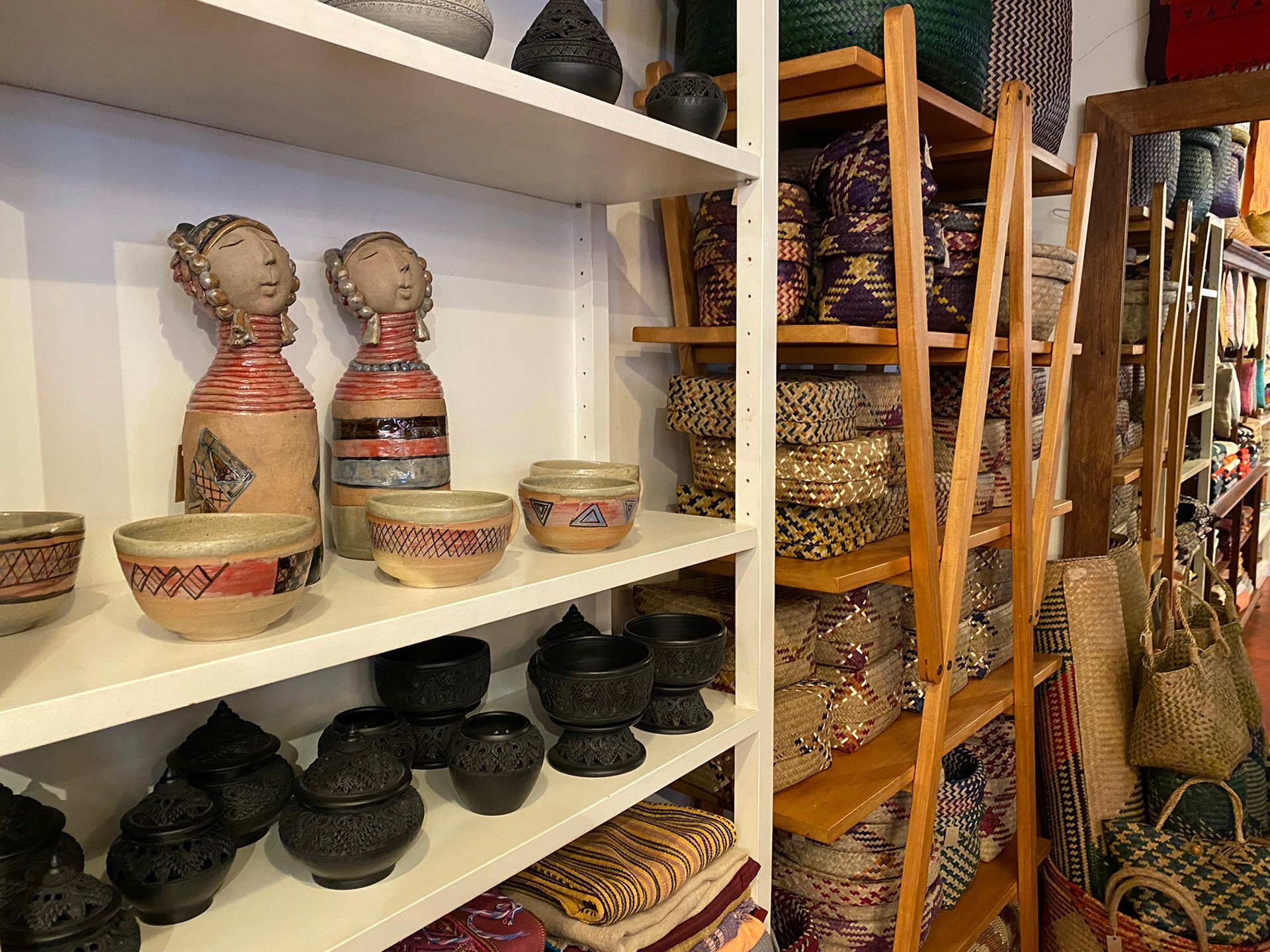
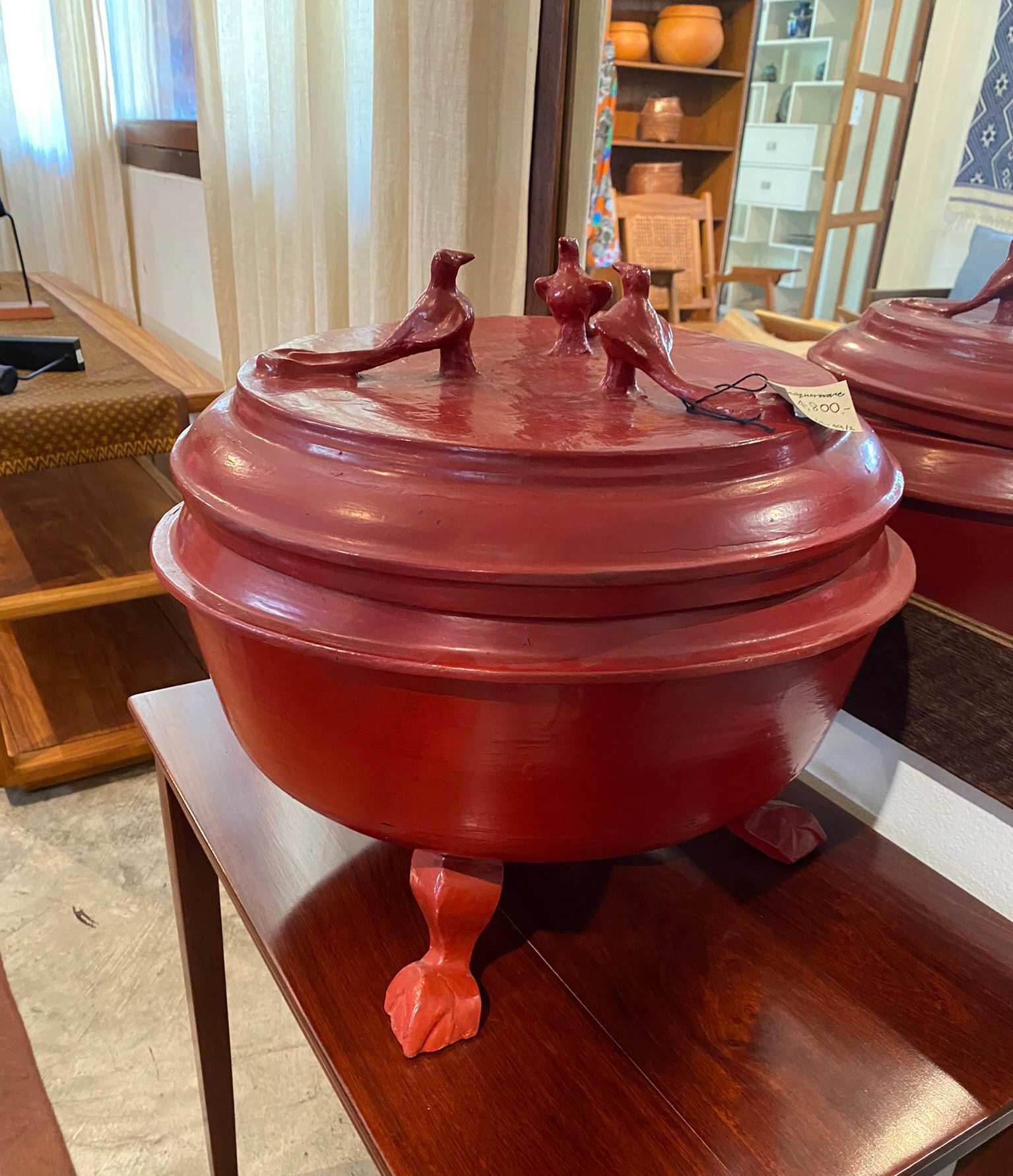
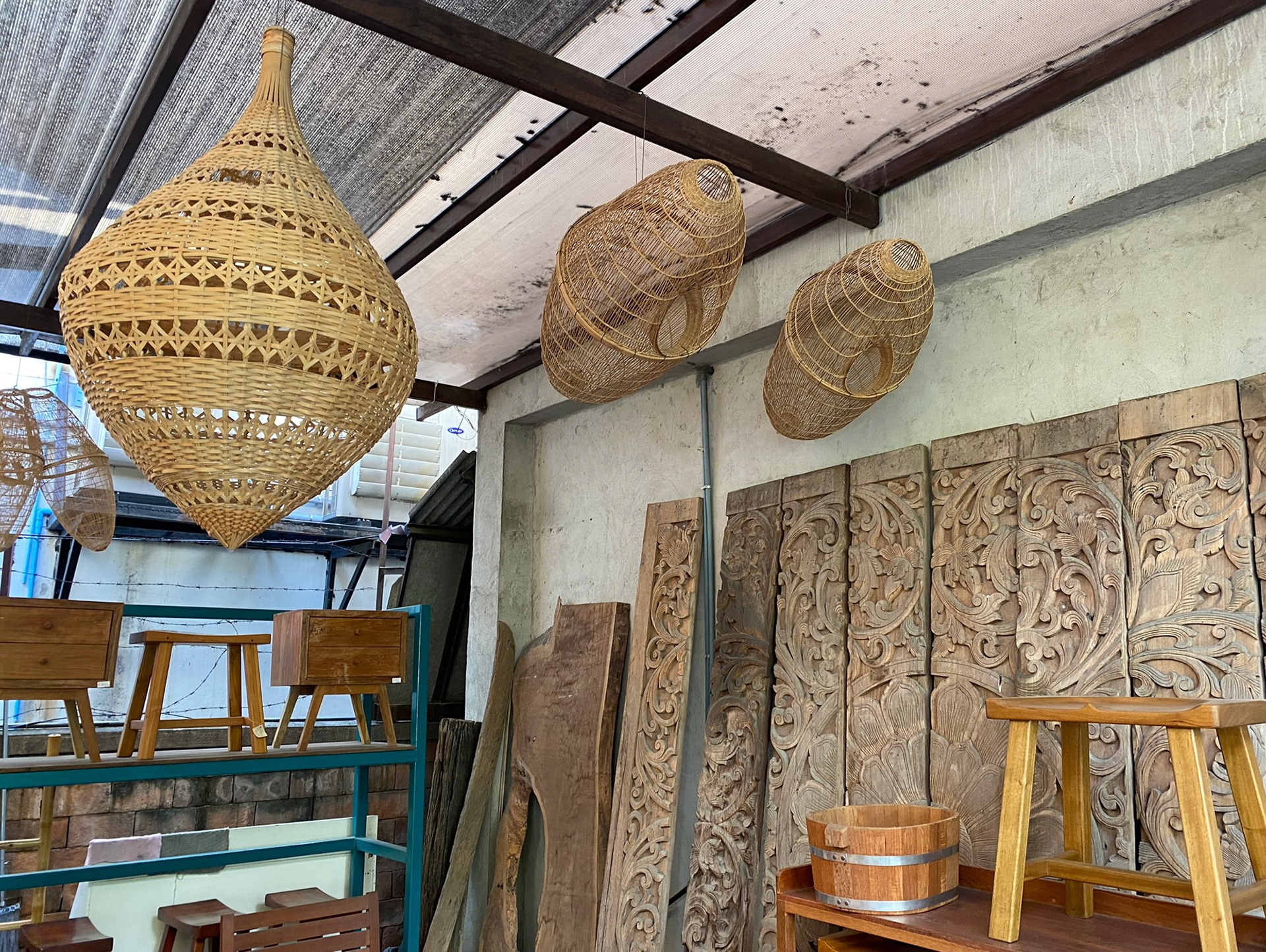
Yorkshire Sculpture Park
In February, we took a school trip to Yorkshire Sculpture park which was a great opportunity to observe many different art pieces as well as a chance to get out of the city for a day. Throughout the fields and forests you can observe many types of sculptures ranging from metal to stone and glass. The pieces that I was most attracted to were the the metal ones as it allowed me to see different types of patinas on their surface to protect them from the weather. One of the images bellow shows a sculpture that has 2 different surface colours and upon observing it further, I guessed that the black sections were applied with a lacquer and the blue sections are patina. I wish the description panels told us what sort of surface colouration it is. Overall it was a really fun day and a great opportunity for me to see patinas acting in their natural environment.
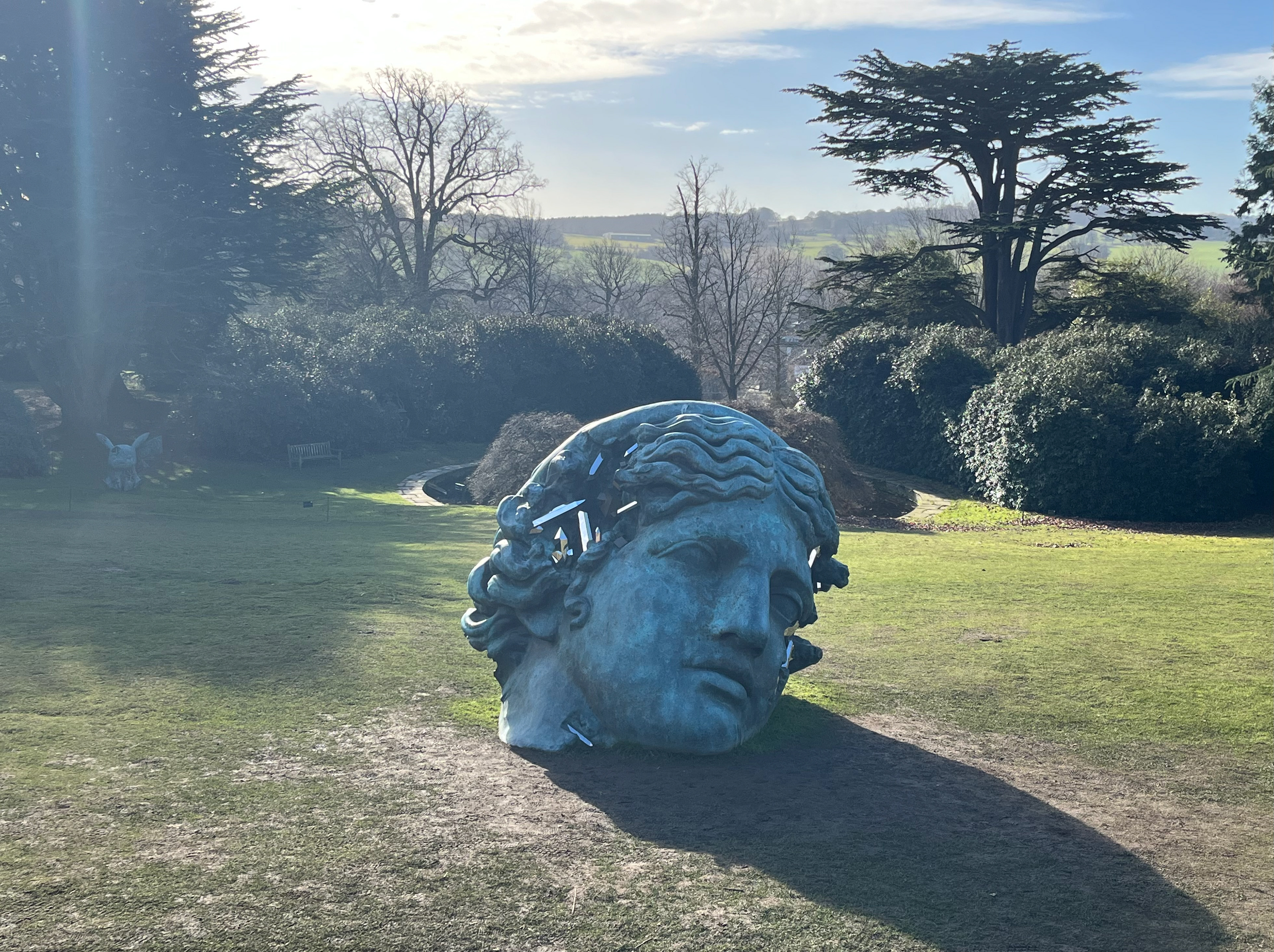
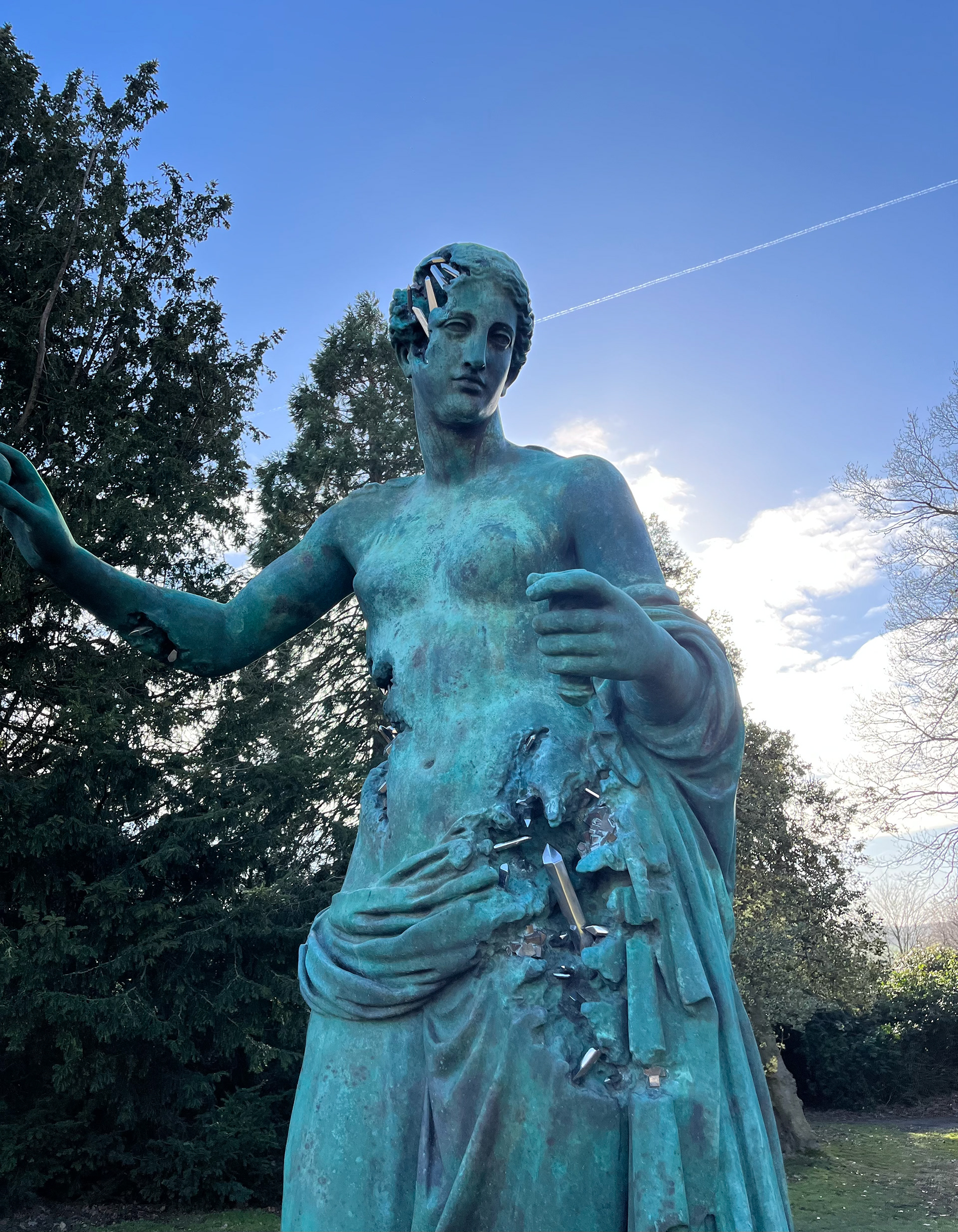
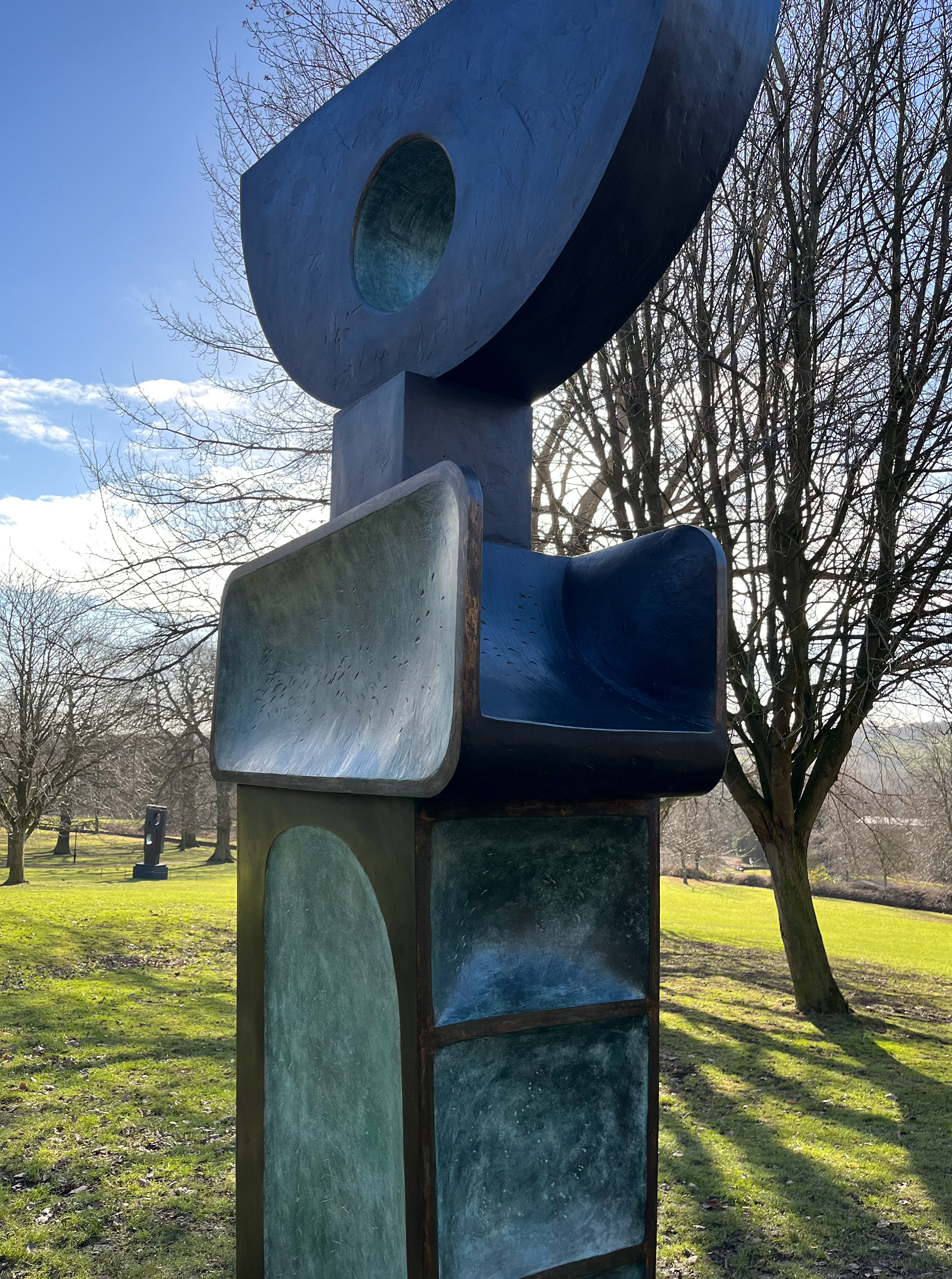
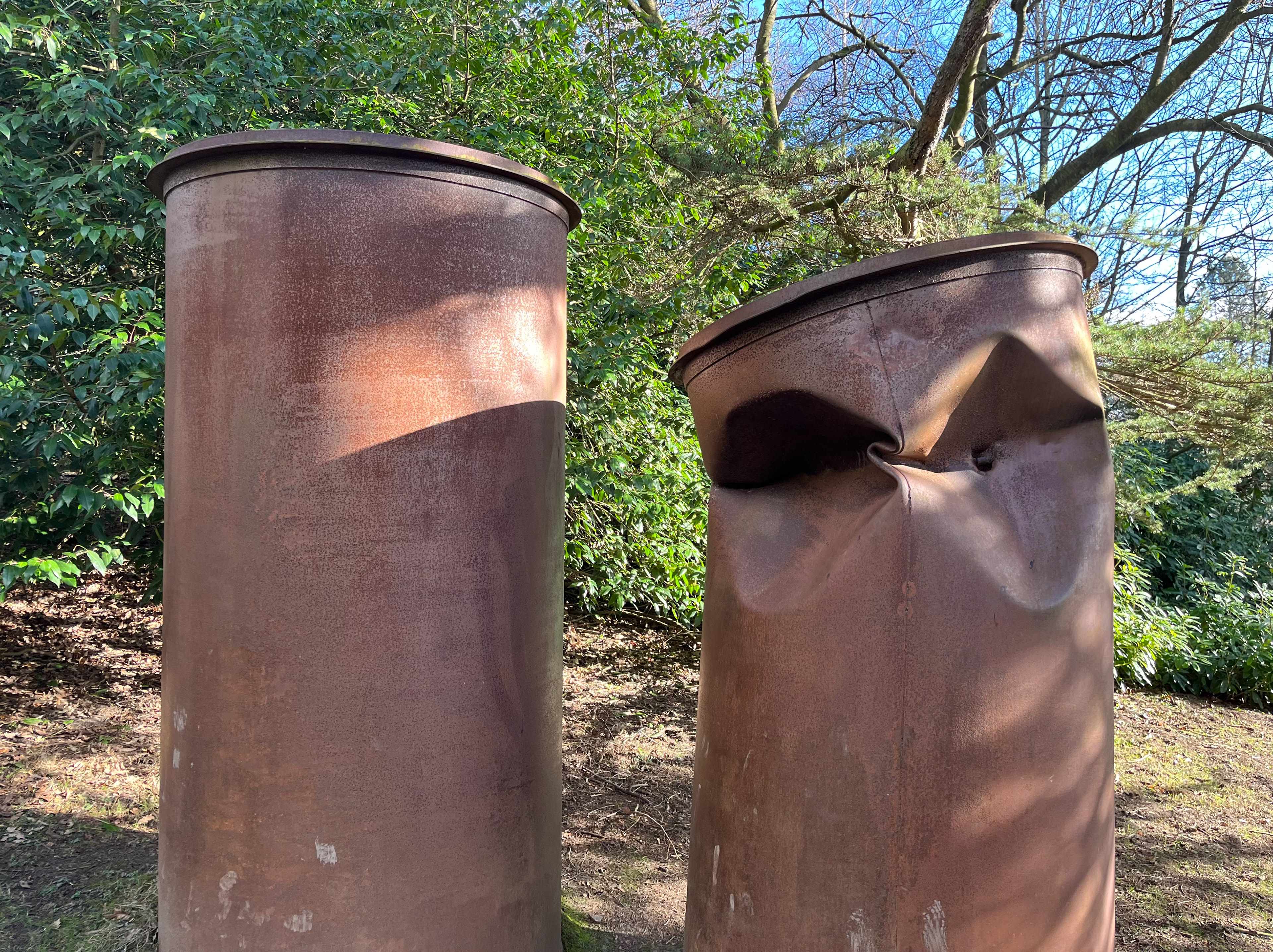
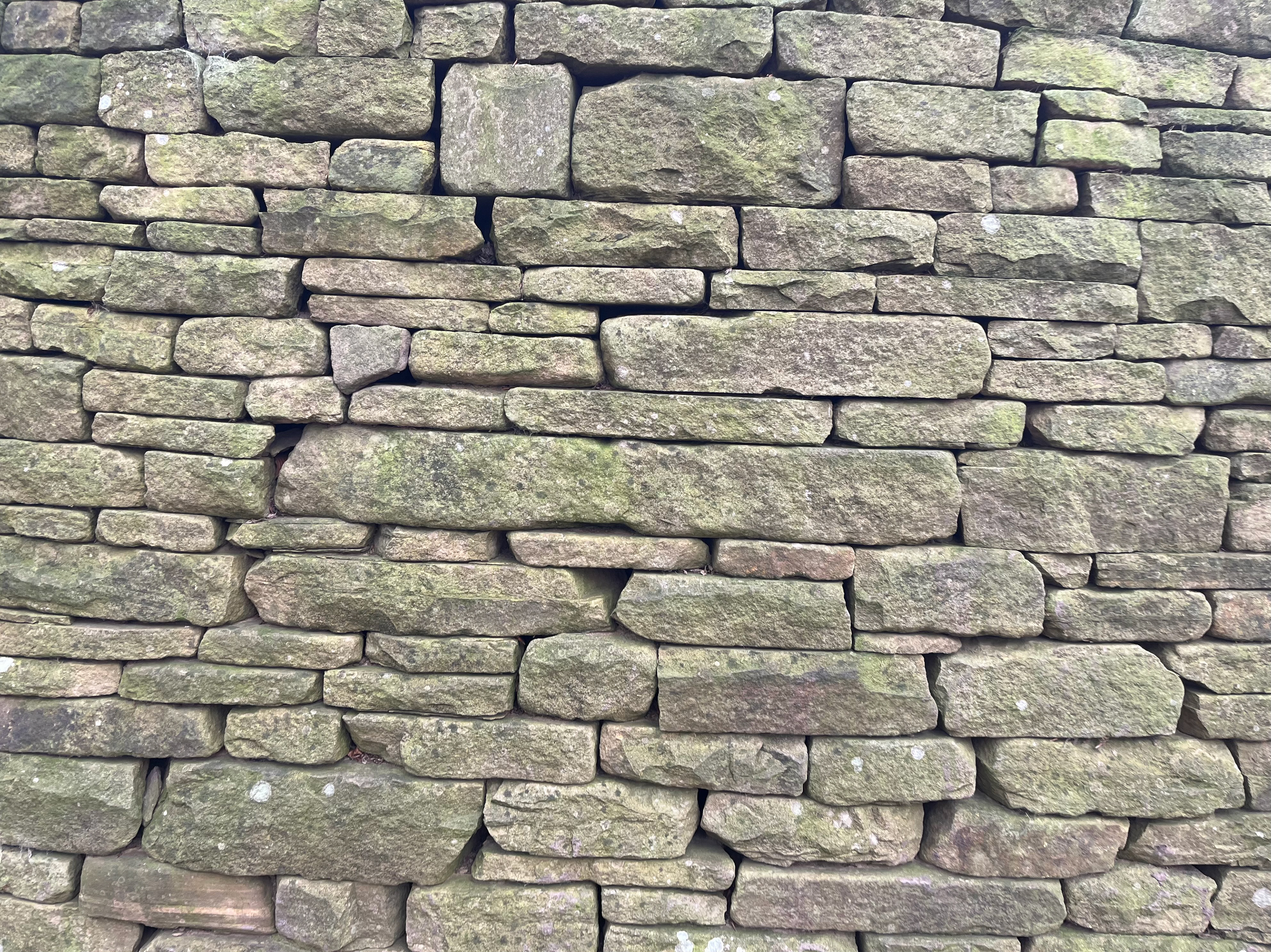
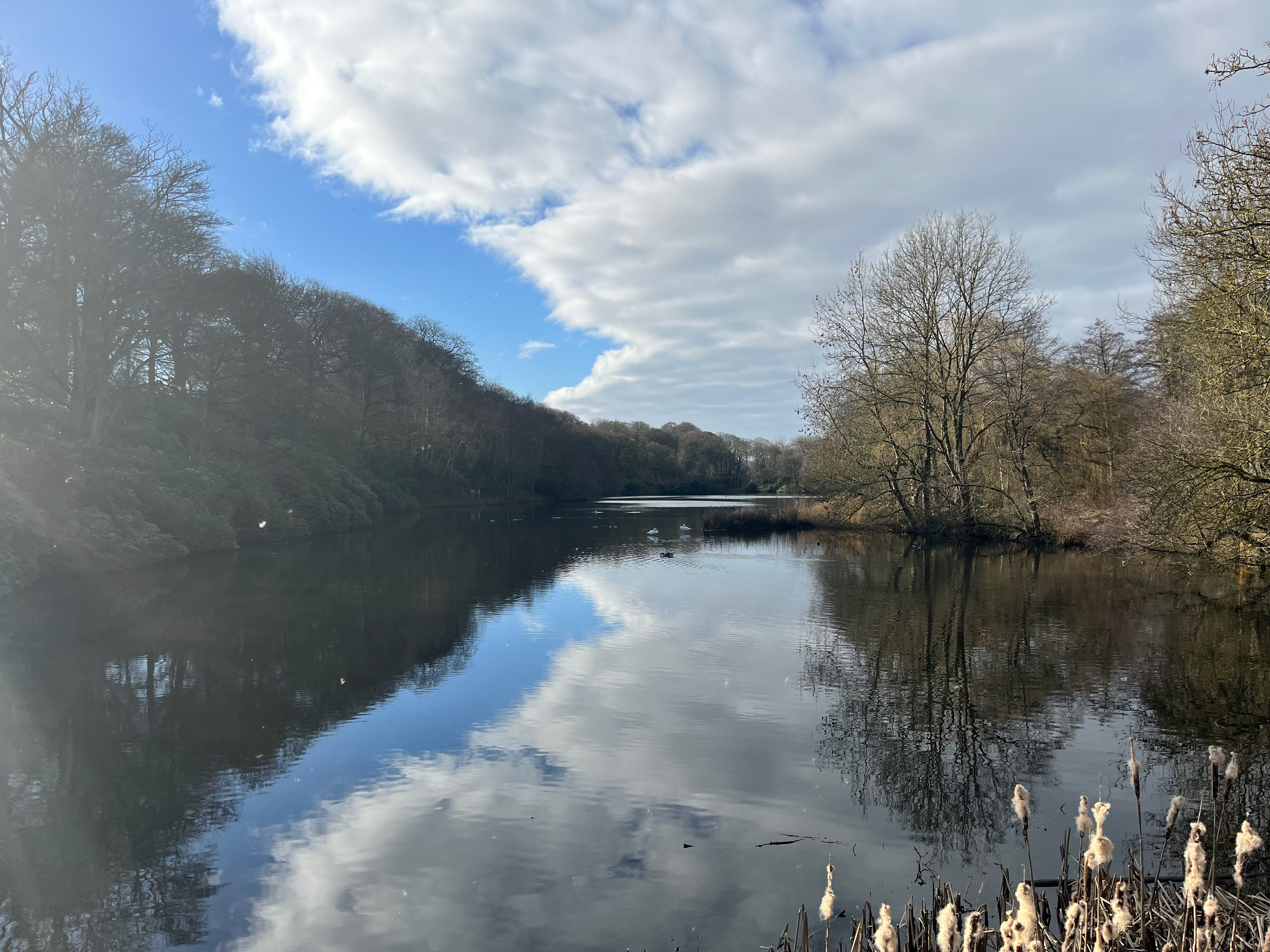
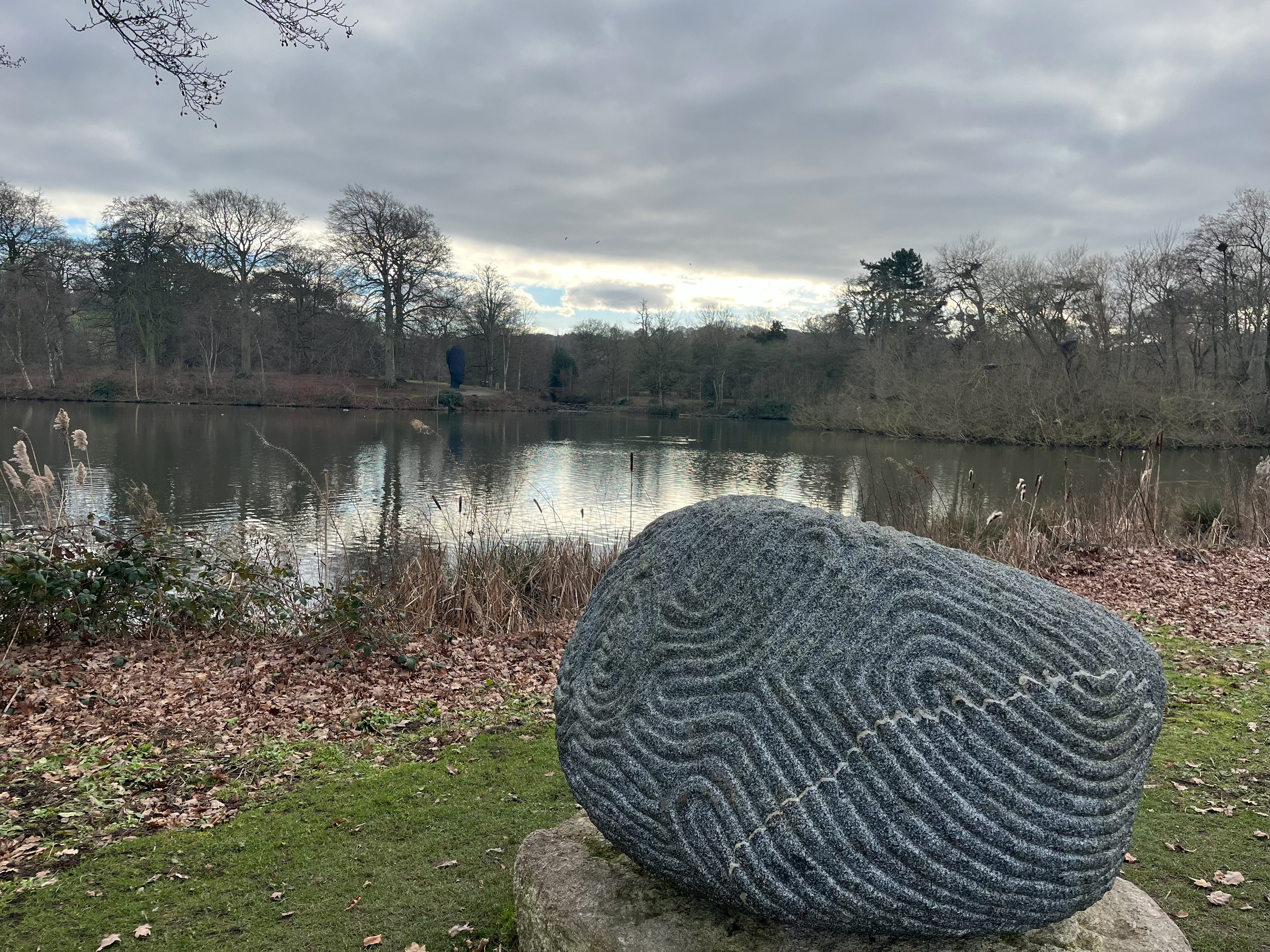

Cara Murphy
In her project, ‘Beach Bowls’, Cara uses the environment around her to influence the texture and form of her bowls. Using the rocks, sand and algae, she hammers into these shapes that remain imprinted in her bowls. I thought this project was very interesting because she used the natural environment to determine the marks created on the bowls, allowing the rocks to form the shapes and letting nature steer how the textures will form. This reminded me a lot about patinas and how as much as I try to control it, ultimately, the patina decides the form and texture it will take. Patinas form depending on the elements and moisture in the soil: the environment determines the colour and texture of the metals surface much like Cara Murphy’s beach bowls.

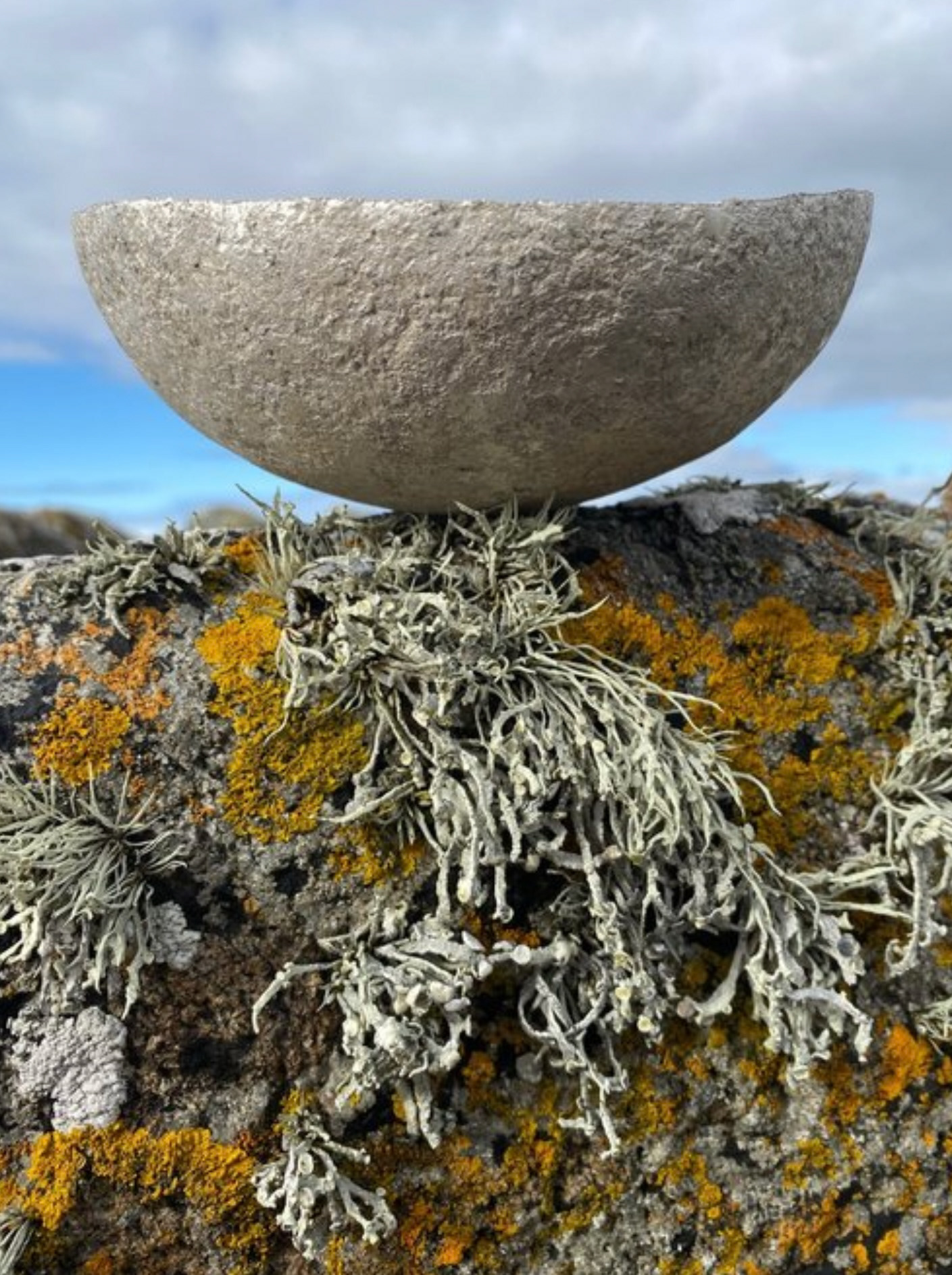
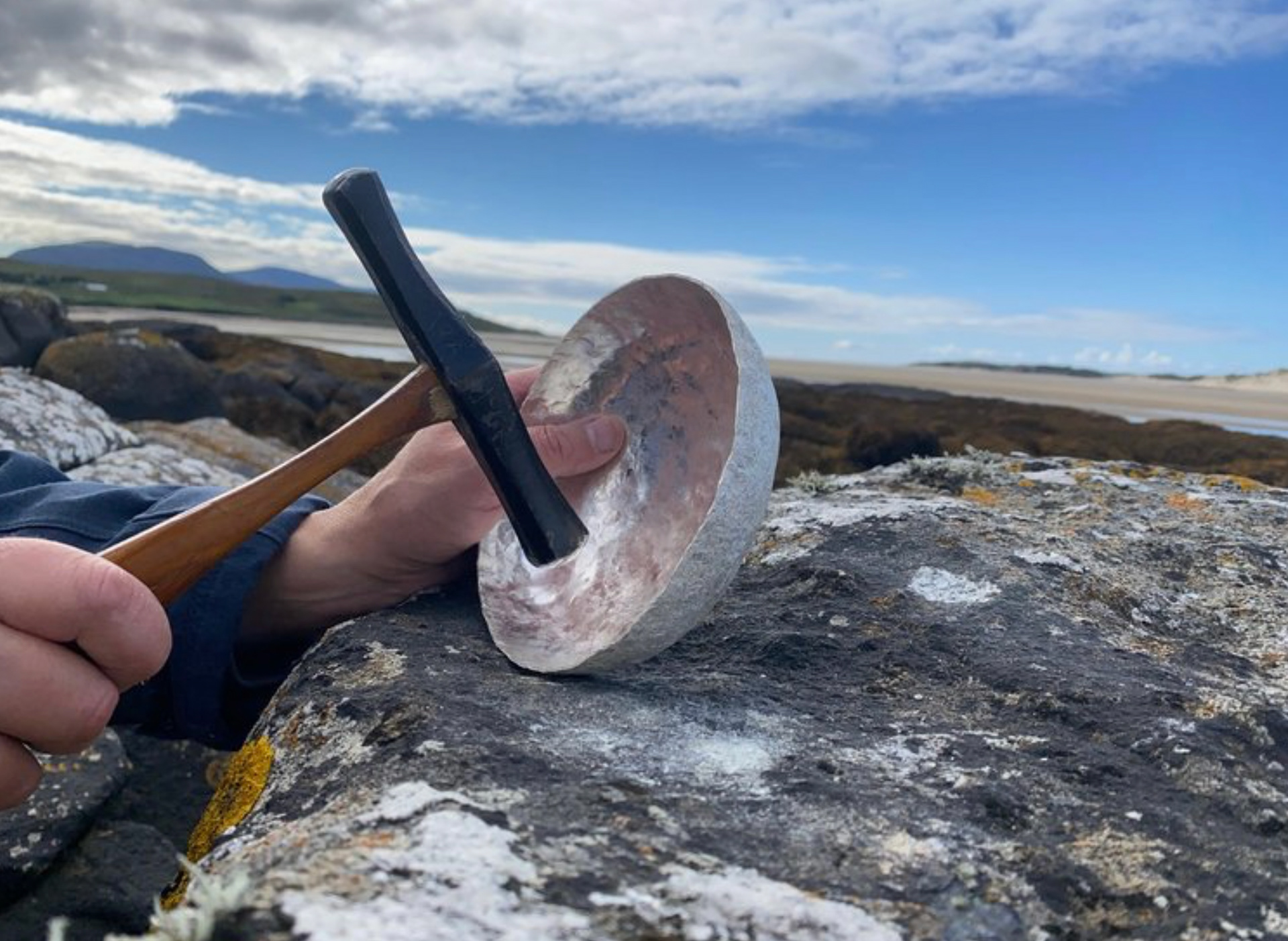
For a similar project, Cara started to use enamel in her bowls to depict ‘A sense of Place’ where she coloured her bowls depending on the colour of the environment. Once again relating to patinas, I have started to think about place in terms of the soil tainting metal in different ways to represent an area where the composition of elements in the ground is unique, showing this through the colour of a patina. This concept has inspired me to conduct similar tests on my copper boxes.
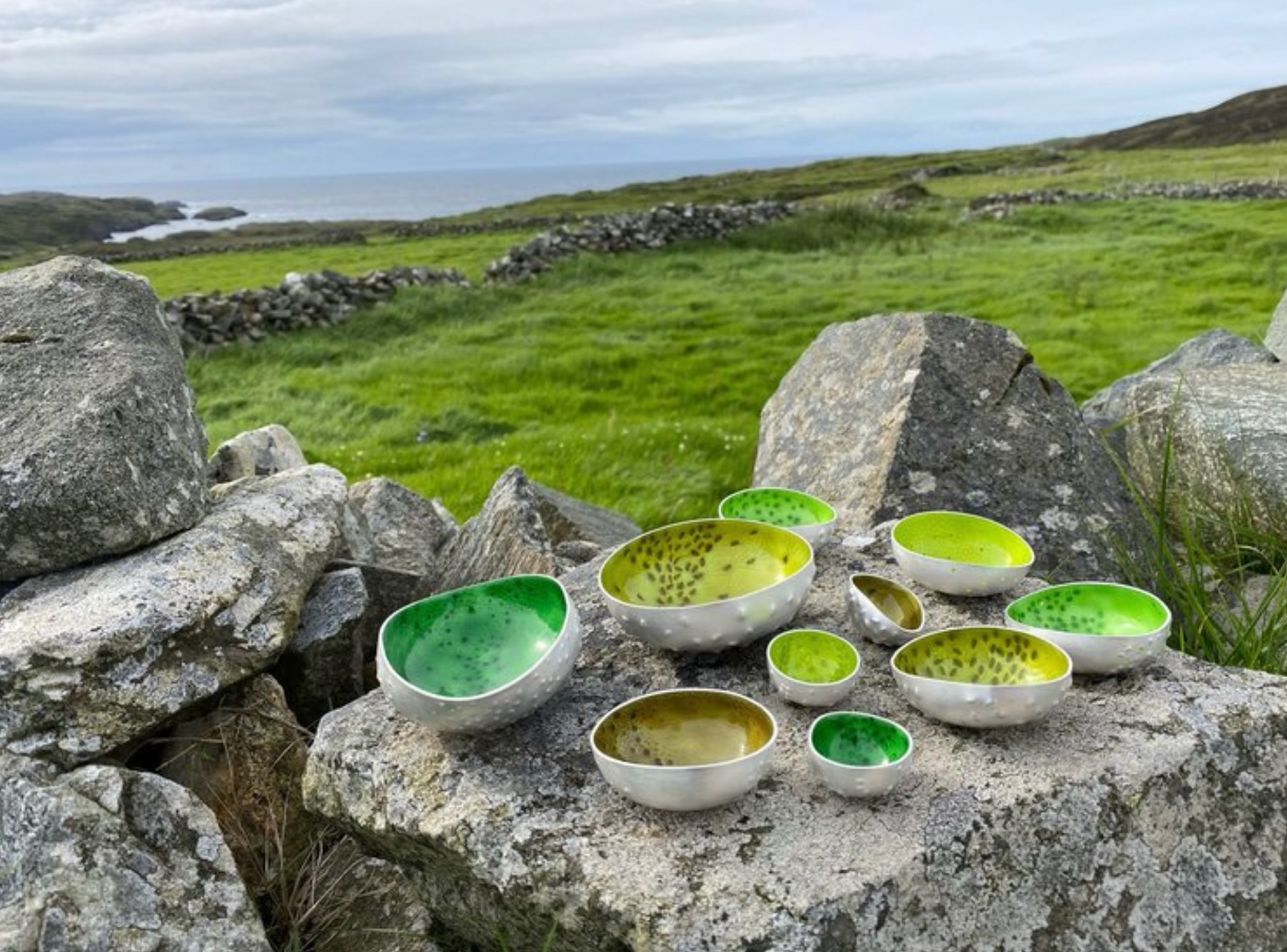
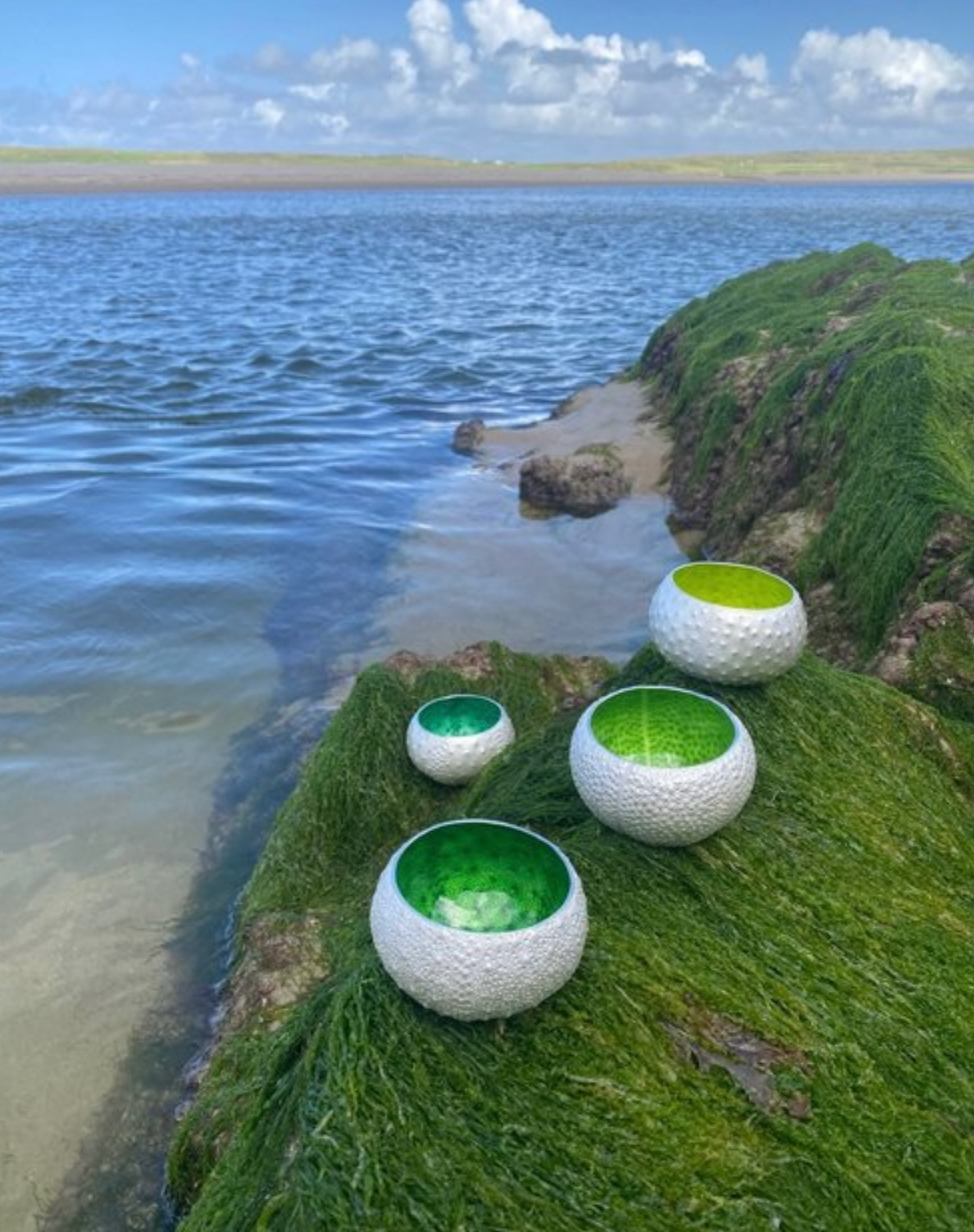
Andrea creates series of boxes made out of a range of different materials: ceramics, glass and metal. ‘Creating box and vessel forms which explore and celebrate the qualities that these ancient and alchemical materials share, including their clarity, purity and transparency […] I seek to make pieces that embrace investigation through their intimate scale, to be held, contemplated and cherished.’
What I find most interesting about them is how within the sandblasted glass, there are obscured objects within, delicate and precious. This gave me the idea of using patination on the inside of my own boxes, to have a seemingly simple copper box from the outside, but when you look within, it reveals a beautiful patina. This also gave me the idea to have nesting boxes, revealing different coloured patinas.
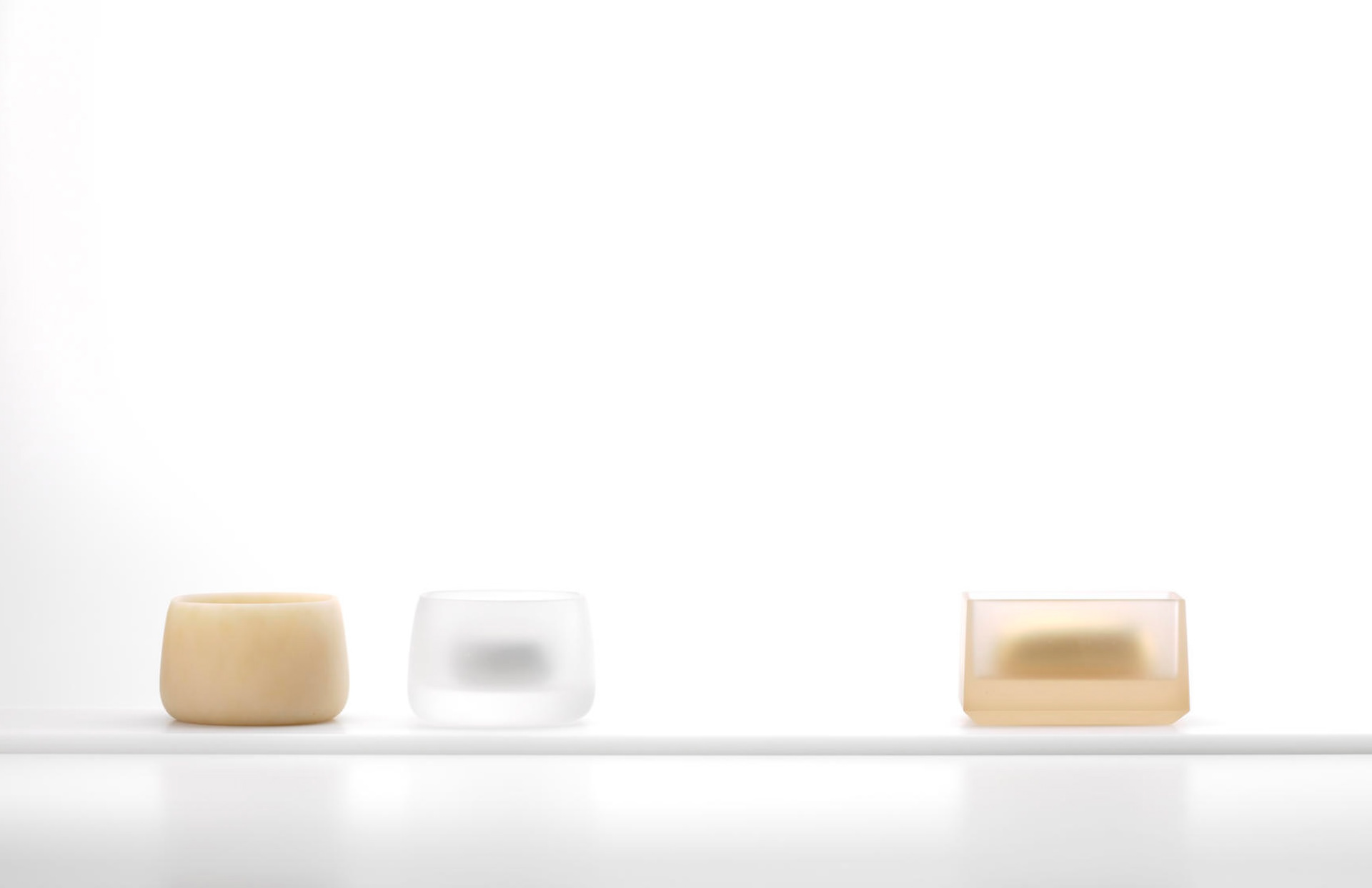
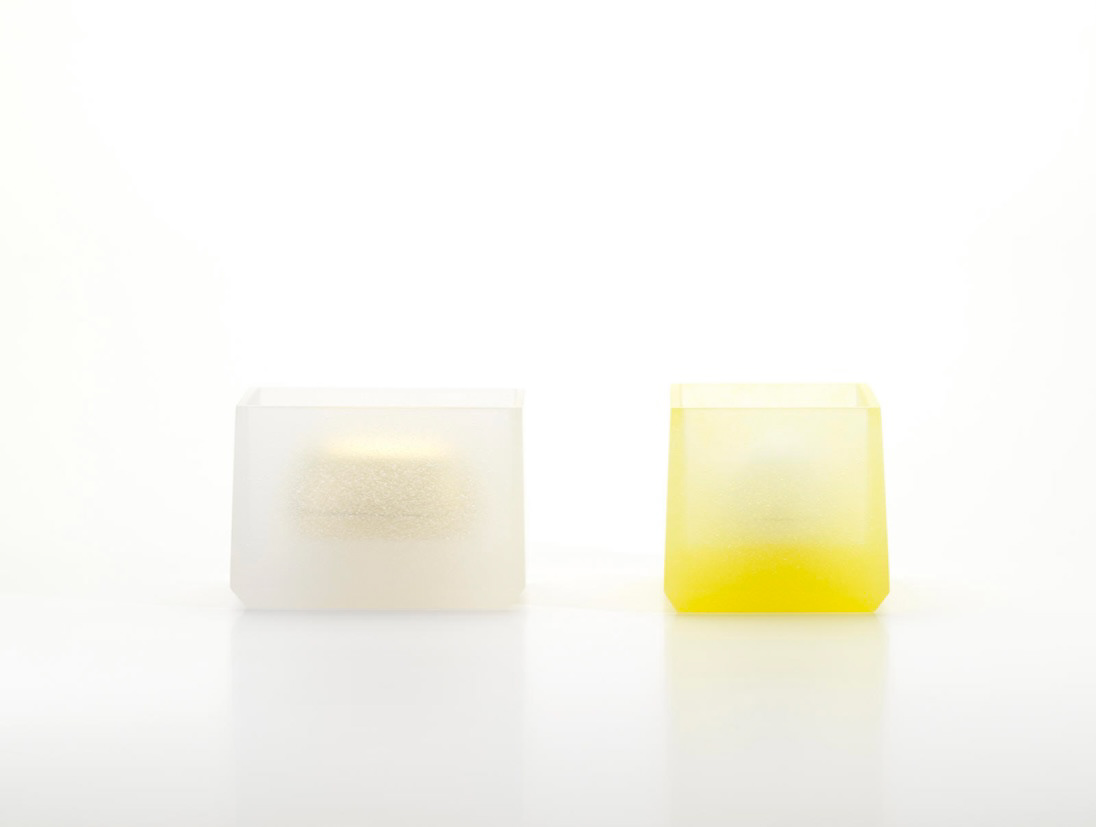
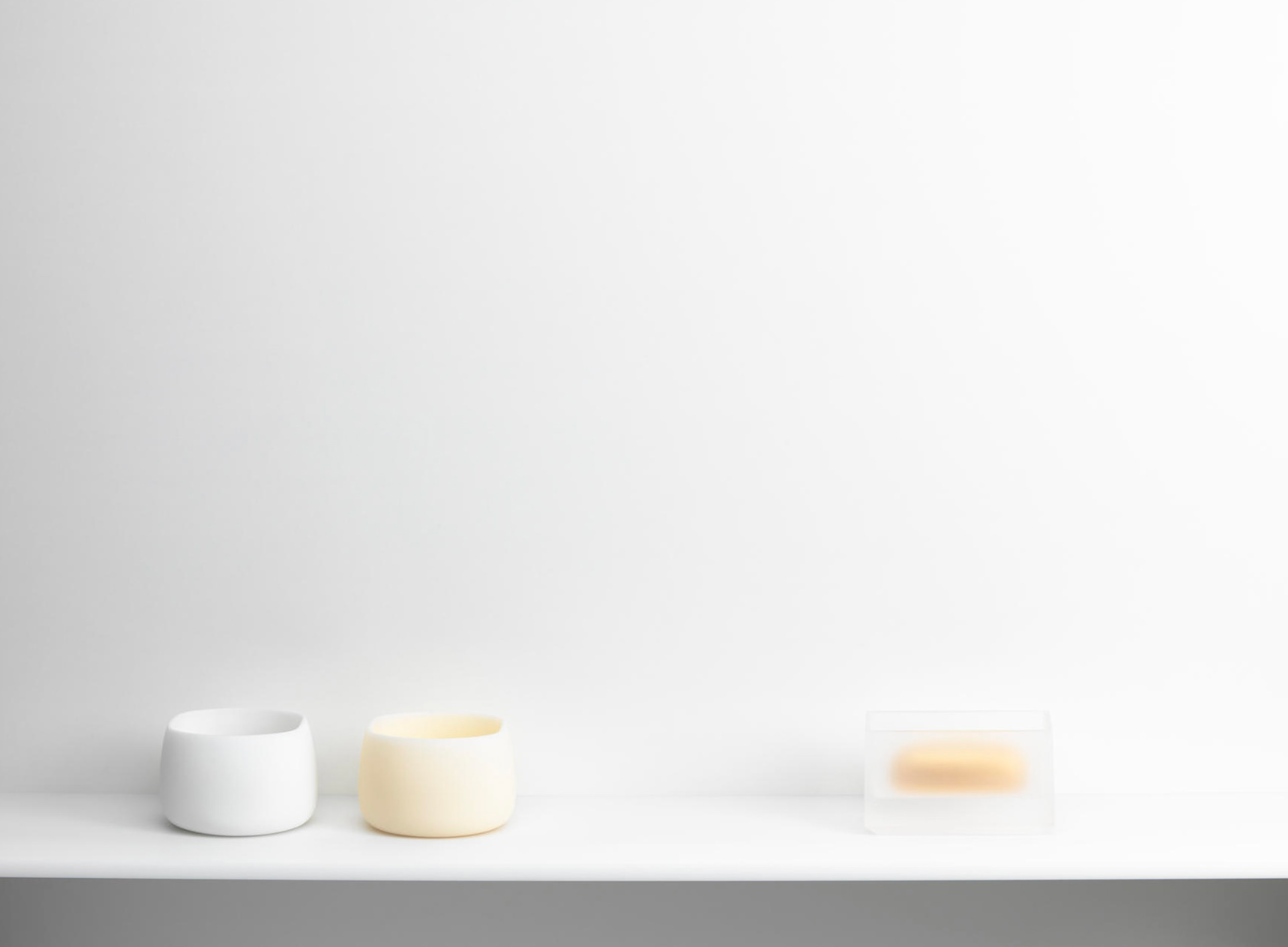
Pollution Patina
The notes on the left are some I took from a report called ‘Technical art history and archemitry 1, Patina: Historical scientific and practice consideration’ by Phoebe Dent Weil. She explains how the increase of fossil fuels in urban areas, is affecting the protective patina layer. Acidity in the atmosphere is starting to eat away at metal, in particular bronze sculptures which are heterogenous in composition which causes ‘pitting’.
This is an issue that I have a strong connection to as I have always been passionate about the environment and its conservation. Upon discovering the effects pollution has on metal sculptures, I wanted to investigate projects that used pollution to demonstrate the impacts of fossil fuels in our cities.
Smogware
I read about this ceramics project in the Netherlands called ‘Smogware’ where they collect pollution from busy urban areas and using the pollution dust, they create ceramic glazes to represent and raise awareness for the increasing fossil fuels in our cities. They collected pollution from cities around the world and it fascinated me how each glaze was slightly different from the next. ‘Poor air quality is made visible and tangible’ to show people how these invisible particles are affecting peoples health.
‘The World table’ brings crockery from different cities together on one table to see differences in air quality side by side from around the world. ‘Differences in colour and texture of the glaze, the tableware tells a story of its origin; about the air quality of the city where the dust comes from.’
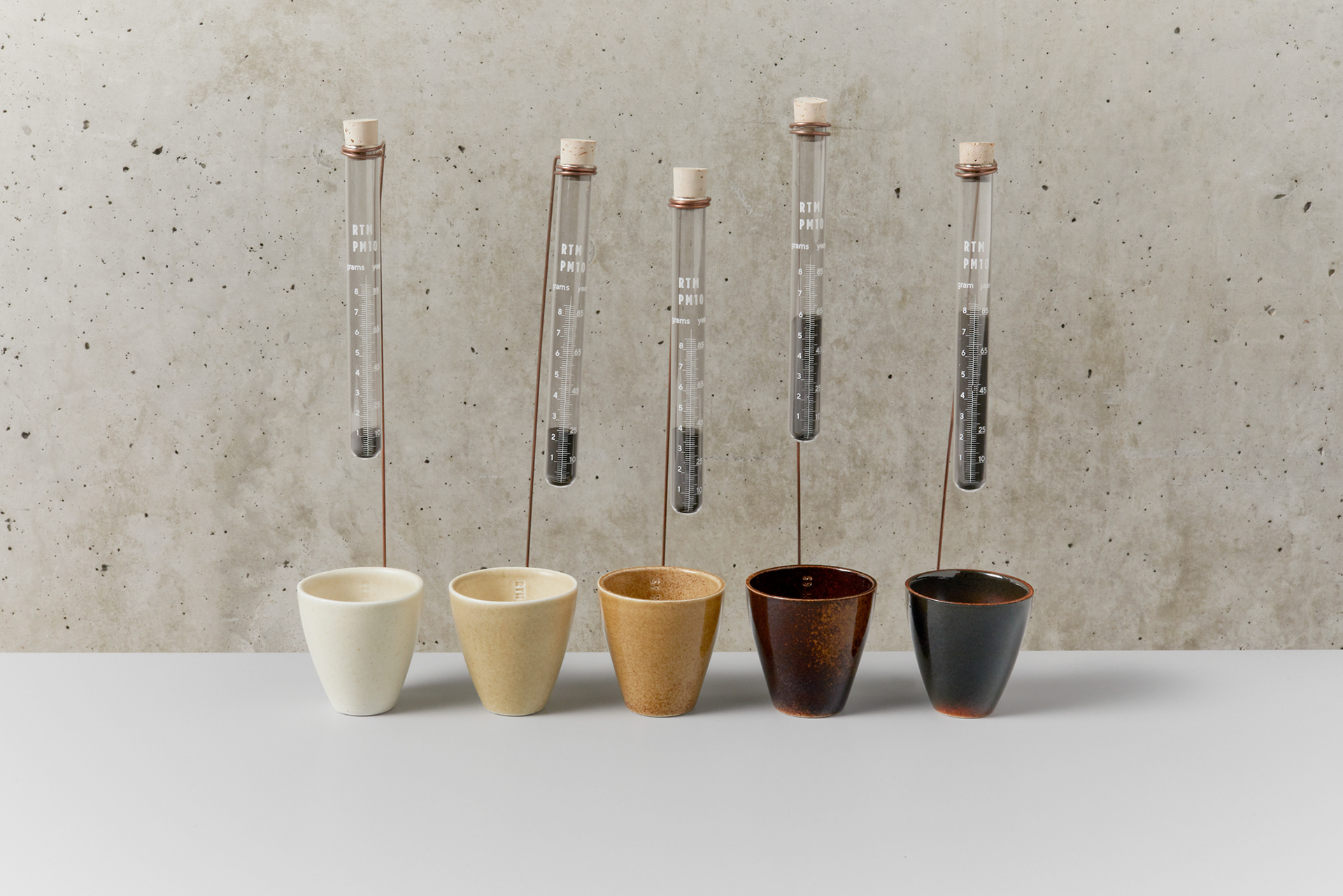
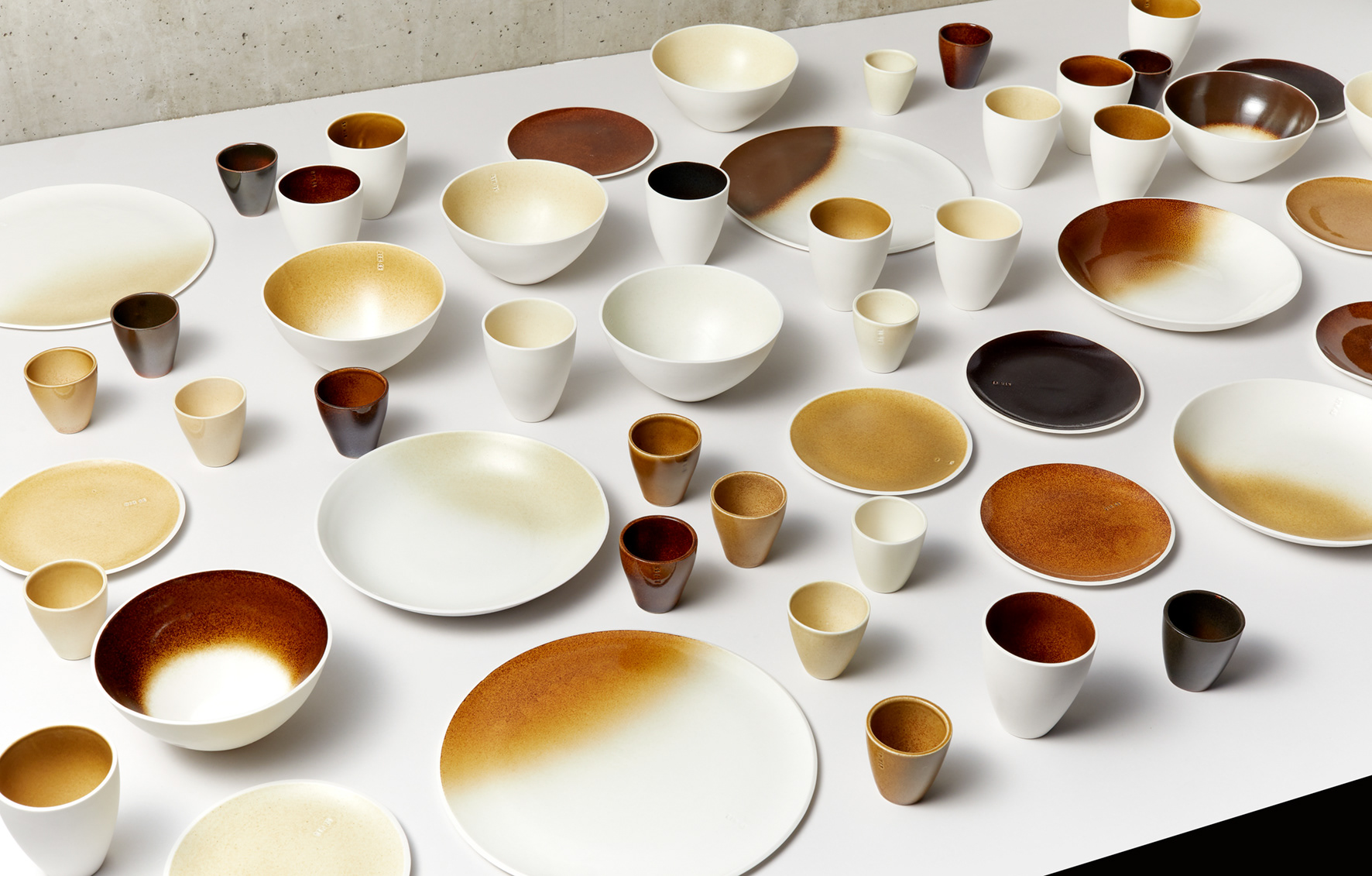
Jacqueline Scholes
Jacqueline is a silversmith who’s work revolves around tableware. Her work is simple and focuses on surface textures and colours. I would like to take the essence of her work and carry it onto mine. With her bowl with the patina, I love the contract between the polished edges and matte blue patina. I would like to try to use this contrast for my boxes.
Very nature driven atelier who creates spaces, furniture, lighting and objects. They primarily work in casting metal and have an interesting use of different patinas to give life to their nature themed designs. ‘Cox London strive to create exceptional pieces that illuminate and animate the spaces they inhabit.’ I really love their work especially their skills with patinas. They are able to capture so many different colours and apply them so beautifully to their installations.
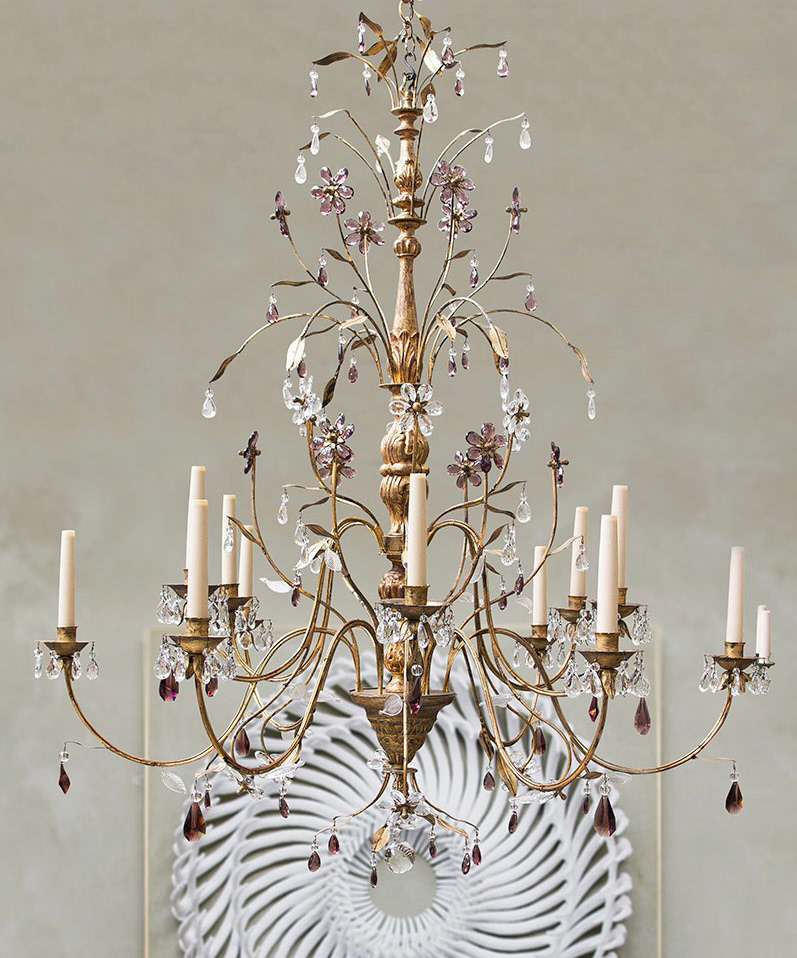
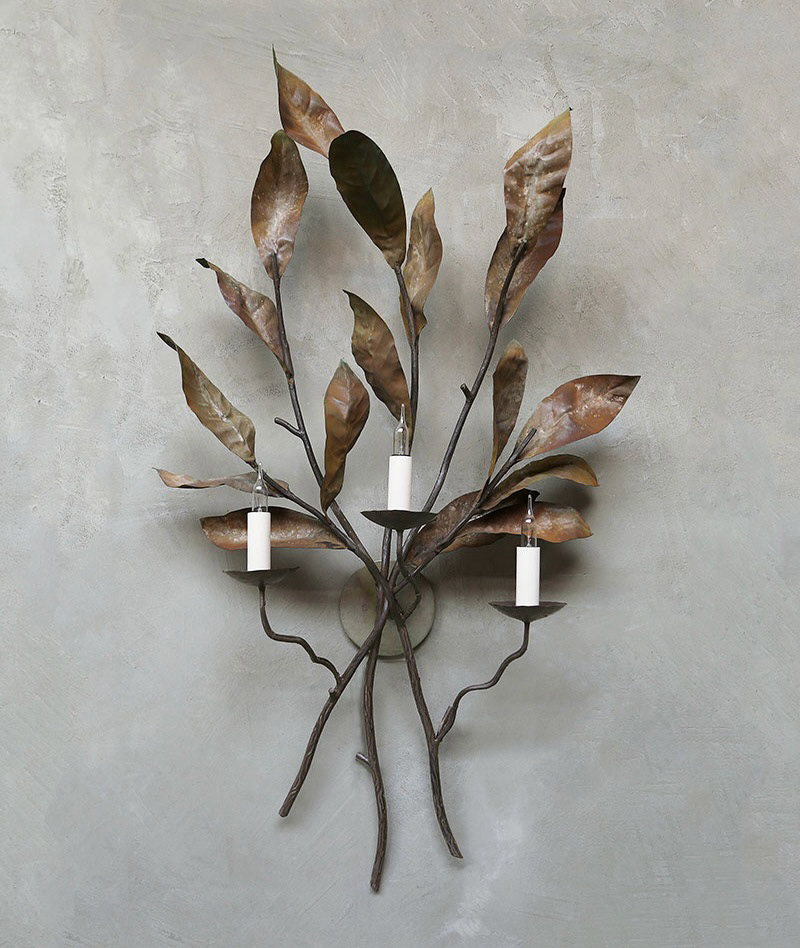
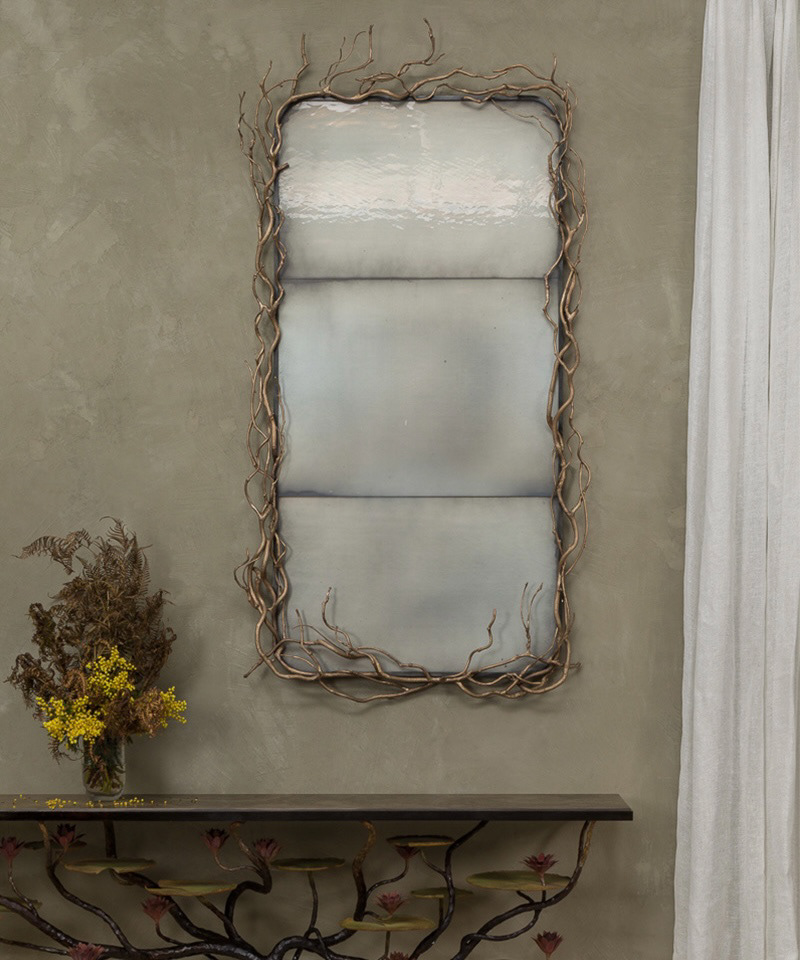
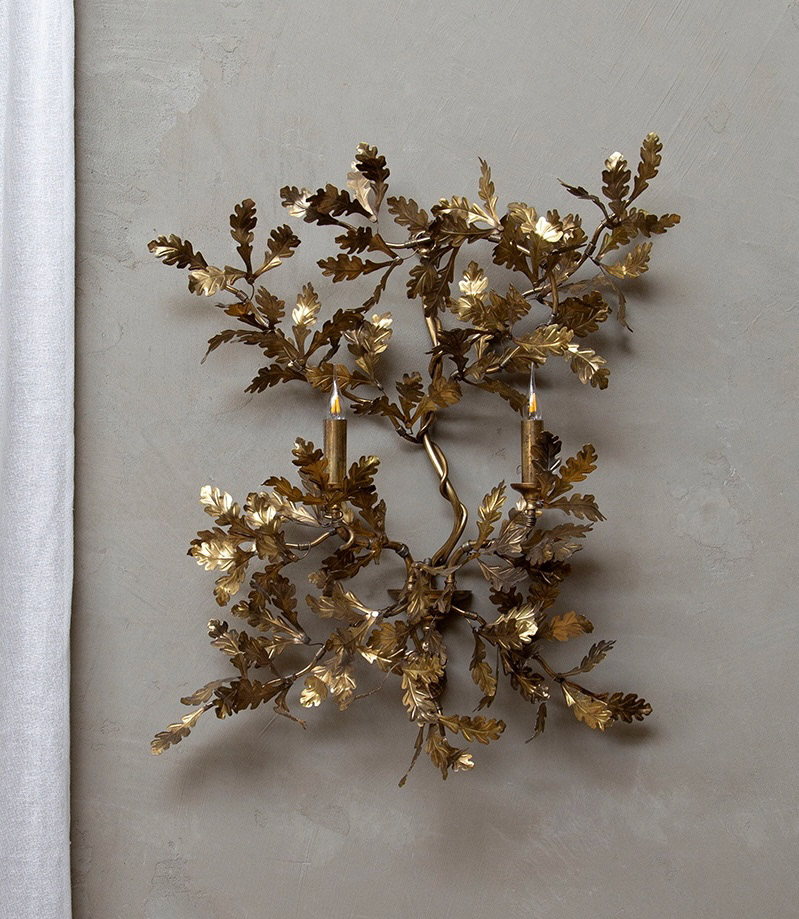
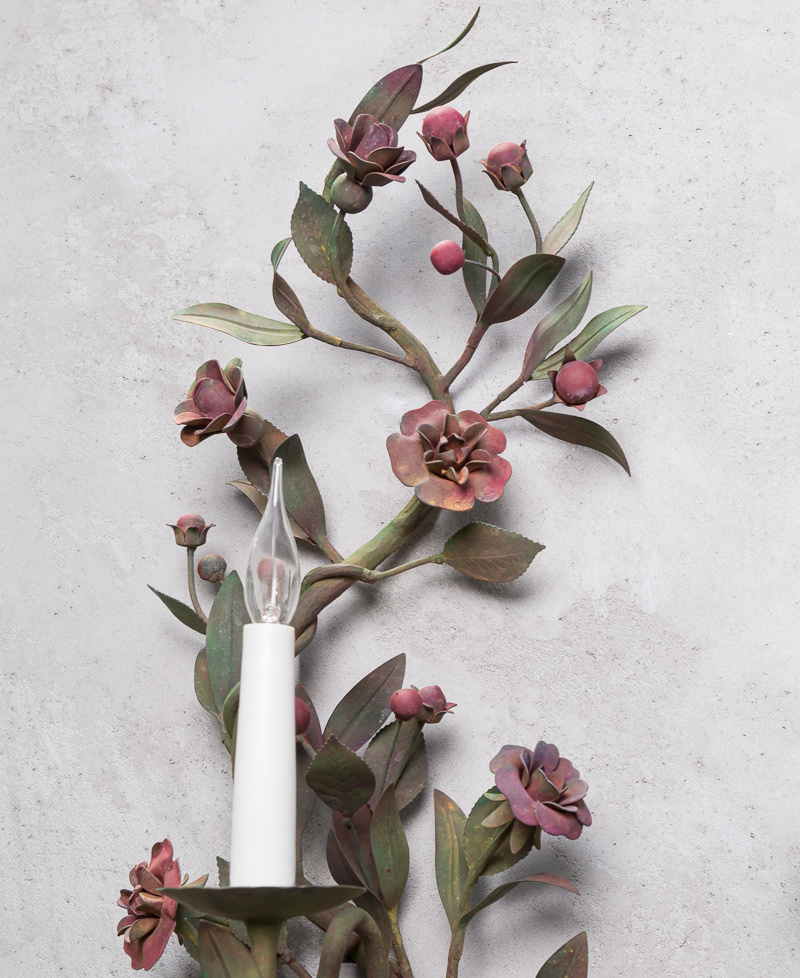

What colour is metal?
I watched one of the ‘What colour is metal?’ Presentations that featured Rebecca de Quin and Jessica Turrell. Rebecca is a silversmith who makes silver vessels that show stark contrasts between polished and patinad metal. She studied at the RCA and is now a tutor there. Her presentation explored her journey through her career as a maker, where she explained her decisions for her colour pallet and designs. Although her patinas are not so vibrant, she uses these darker and duller colours to show a better contrast between a highly polished silver and matte patina.
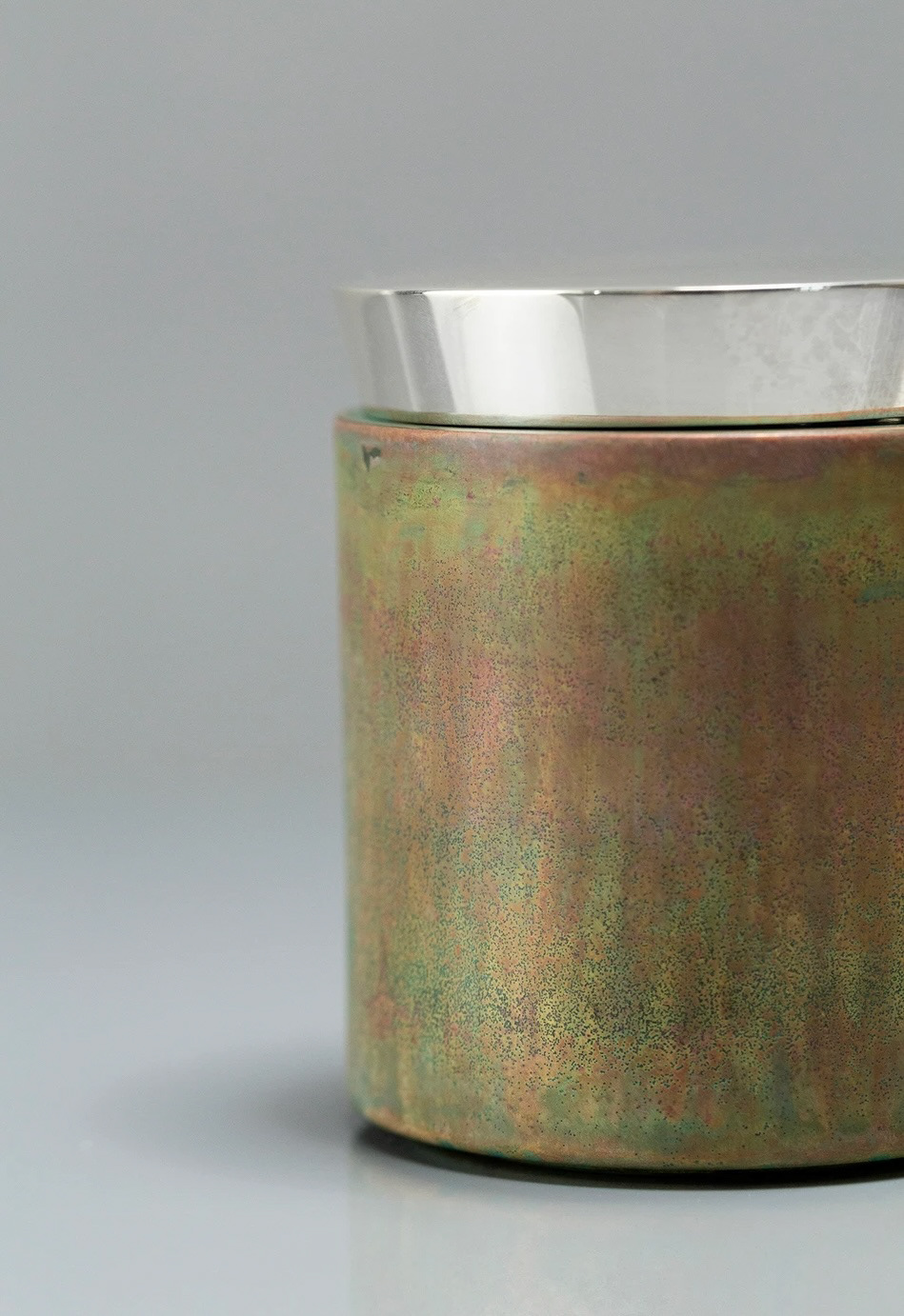
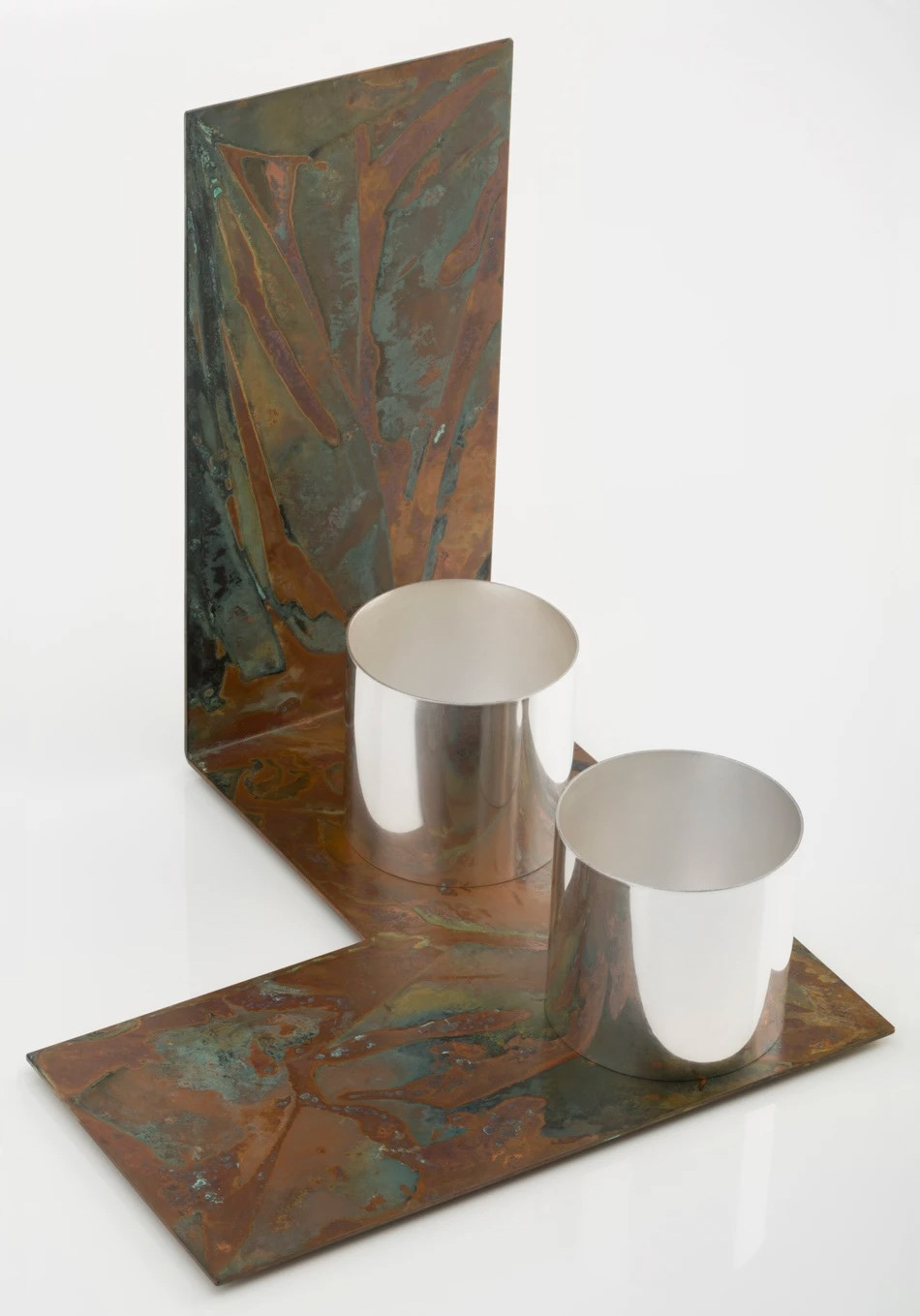
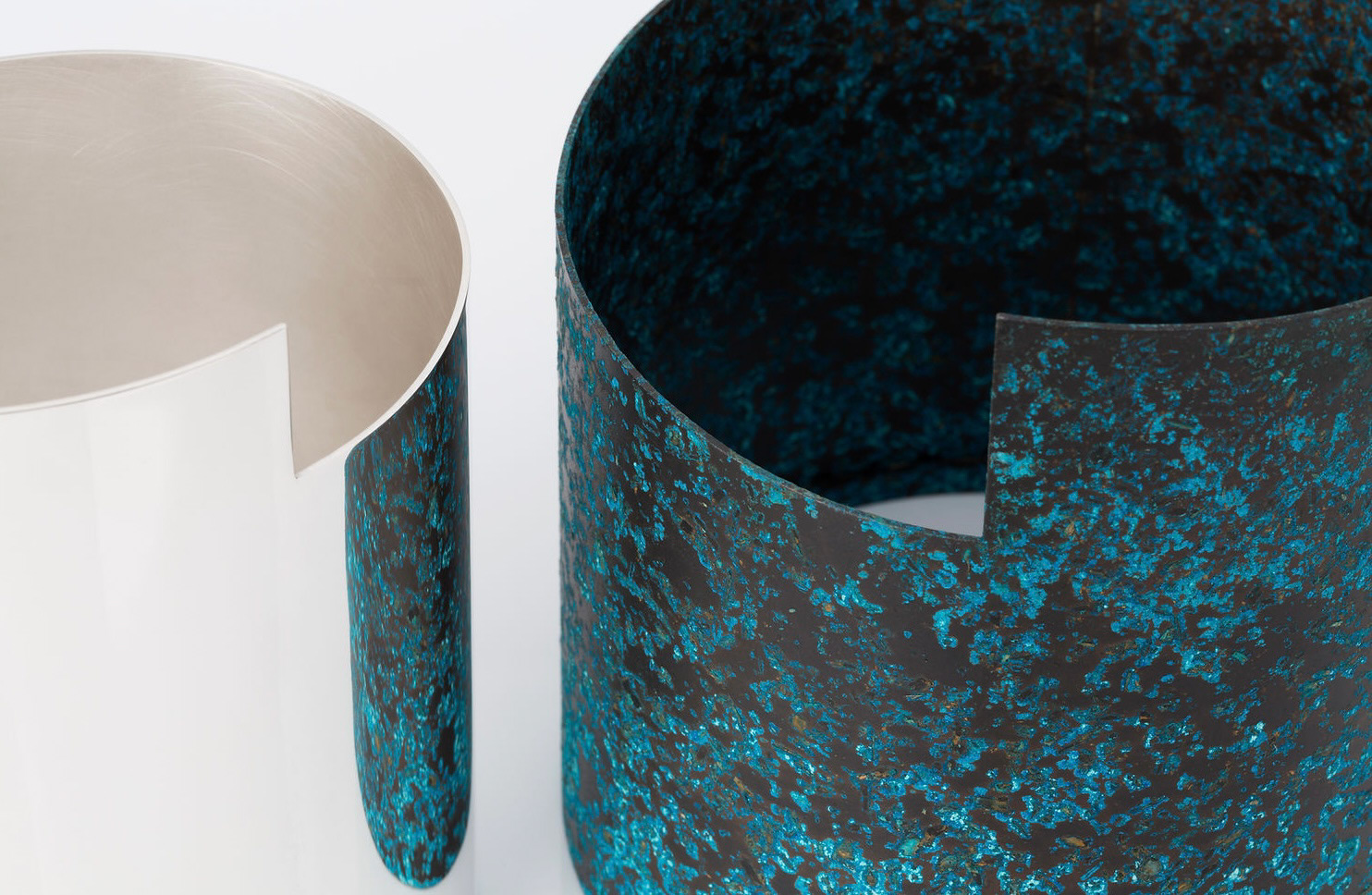
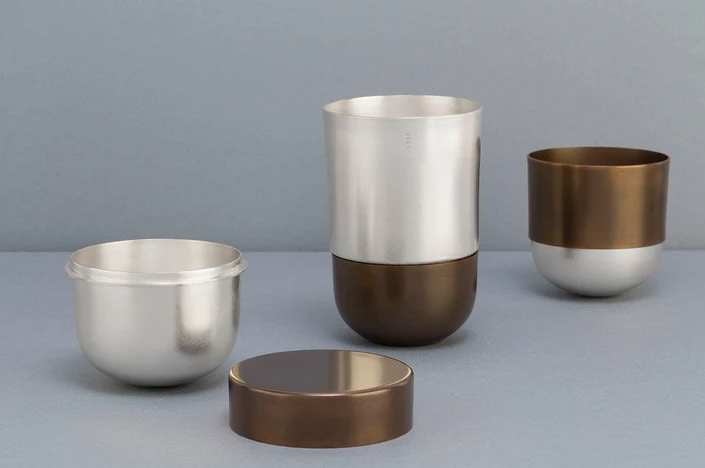
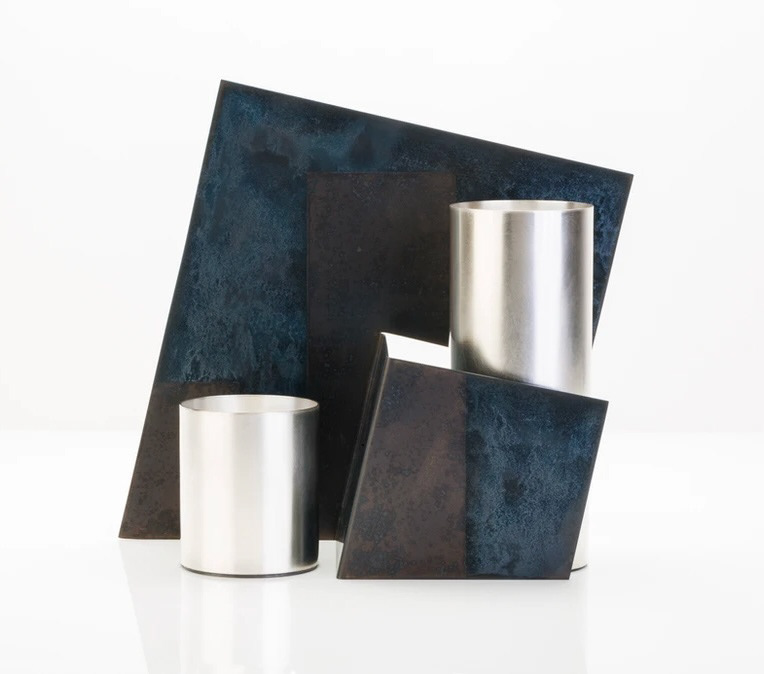
Jessica Turrell is an enamel jeweller who practices traditional enamel techniques in a contemporary context. She’s done extensive research into mark making techniques that allows her to explore different surface textures and patterns. During her presentation she explained that working with copper allows her to take more risks and be more playful than with precious metals.
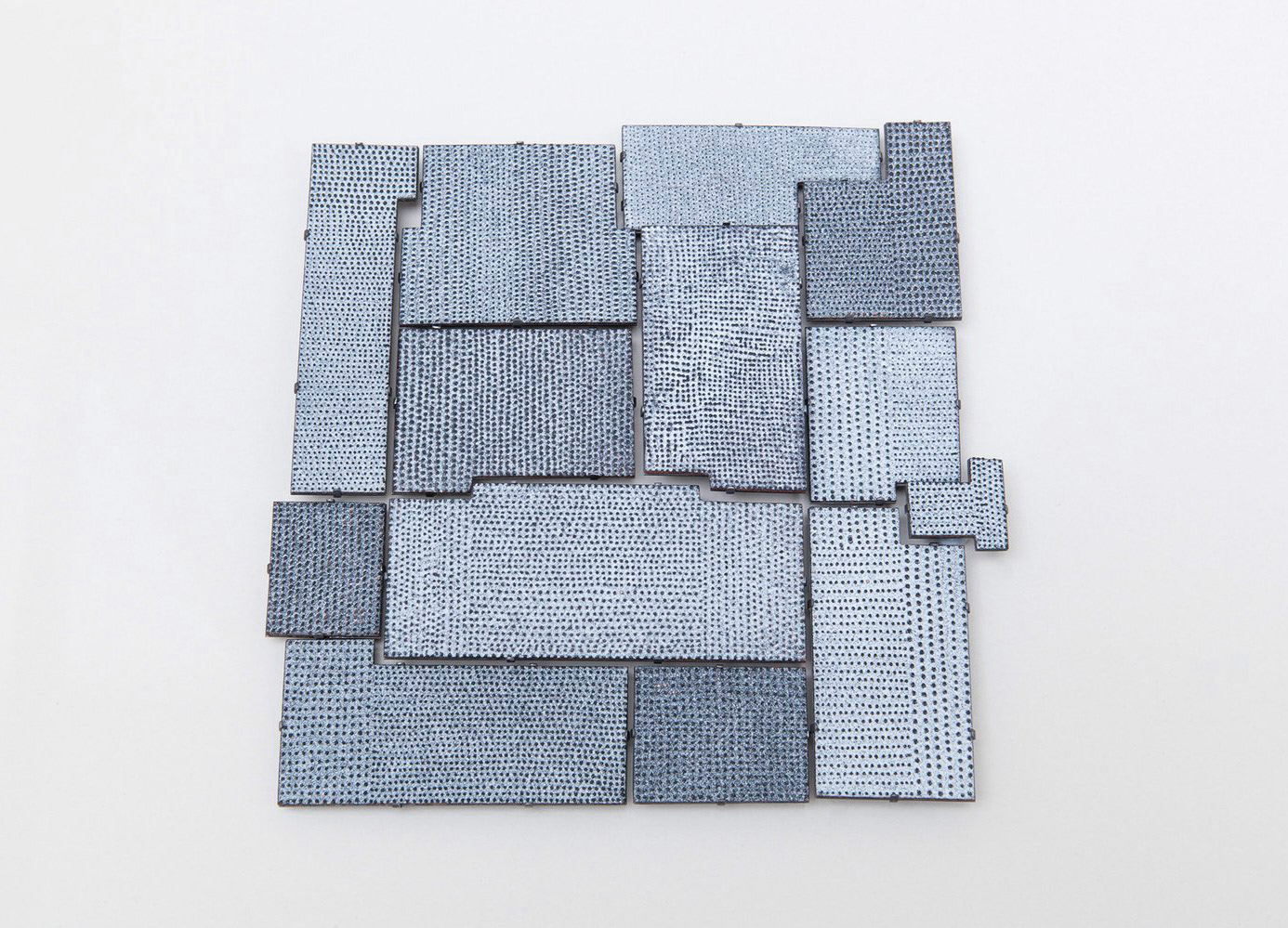

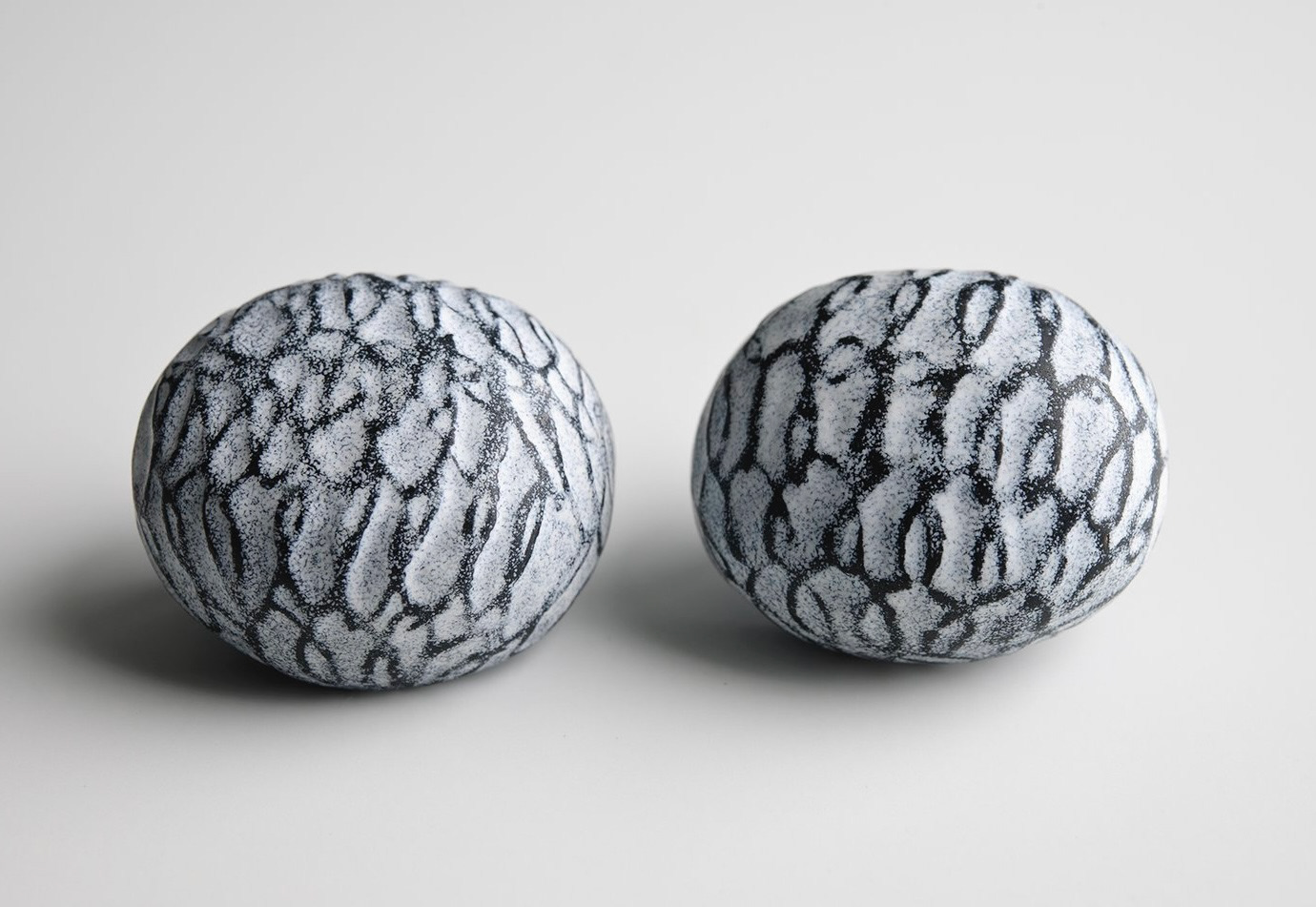
Ian McIntyre
We had the opportunity to have Ian McIntyre and John Booth come in to give a presentation about their projects and their career. I was particularly interested in Ian McIntyre's talk as it was very inspiring and made me feel optimistic about my future practice. I was most interested in his project on pewter because he made his products responding to the features and properties of the material. With pewters low melting point, he could swirl the molten metal in a bowl and as it solidified, it kept a liquified look, creating very unique and beautiful bowls. He designs through making which is something I very much strive to do with my projects. With this project, I didn't have any initial sketches for my forms. But I made paper models and tried replicating it with copper sheet. This way I discovered how soft copper was and how easily manipulated a sheet can become and through this process emerged some very lovely vessels that from a first glance, look like they were made from paper.
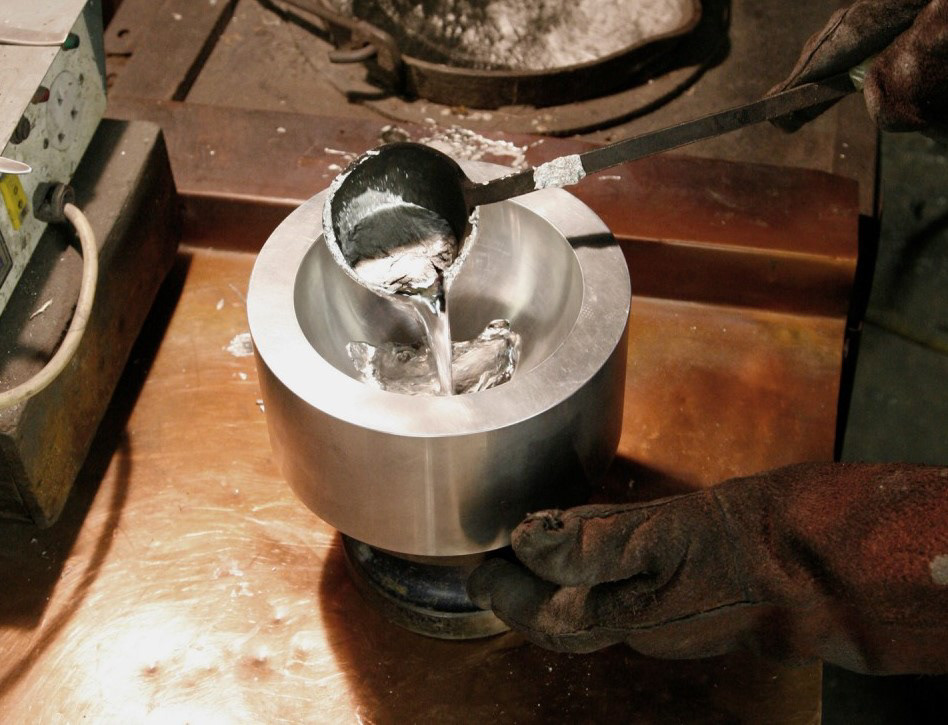
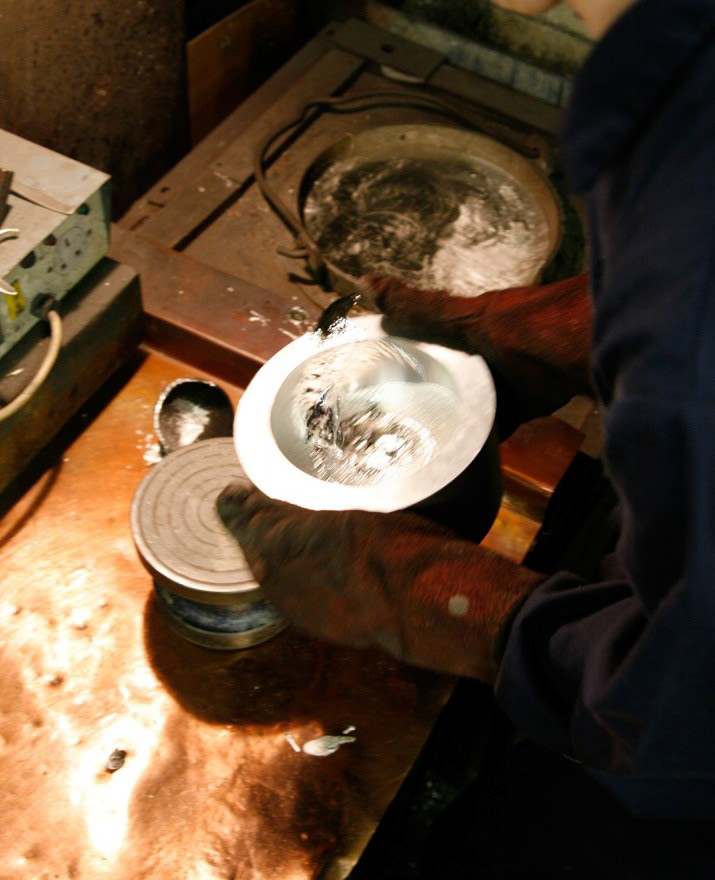
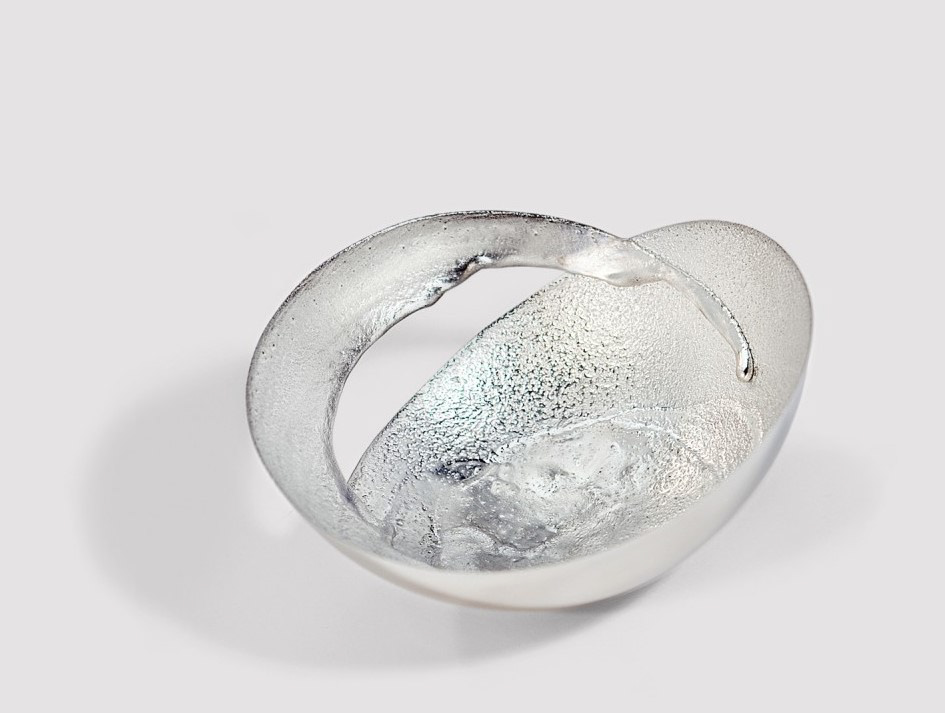
Rokusho & Niage
As part of Unit X I wanted to explore different patination techniques and see what other colours could be created. Since I had already mastered the blue/green patinas of ammonia and vinegar, I wanted to explore the other end of the colour spectrum, Red.
This was when I came across an ancient Japanese Patina ingredient called Rokusho otherwise known as copper rust. Since the Japanese are so secretive about their craft techniques, it was really hard to source the ingredient online outside of Japan. I manged to find a chat group on Bladesmiths Forum where they discussed different techniques of how to make this ancient solution. This seemed like a viable option but I wanted to find a Rokusho recipe that was authentically Japanese and true to how the ancient Japanese made it.
I then followed someone's advice on the chat page to buy the rokusho solution from Reactivemetals who sold authentic Japanese patina solutions, one of the few outside Japan. When browsing their website, I tried calling the contact number but unfortunately was a discontinued number and I imagine the website hadn't been running for at least a few years.
I then discovered this very useful book extract that went into depth about the ritualised process that is Rokusho and Niage making. Written by a Japanese man, Eitoku Sugimori, I knew I found the jackpot. However, I ran into another problem which was, the chemicals needed to make the solution where very difficult to acquire. So I emailed the chemistry department to see if they could help me out with this.
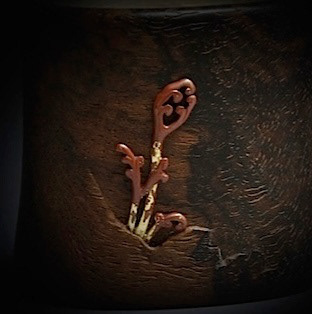
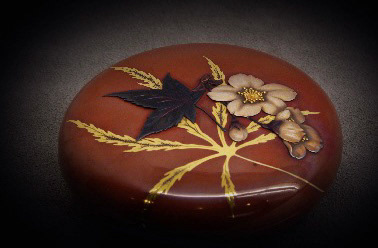
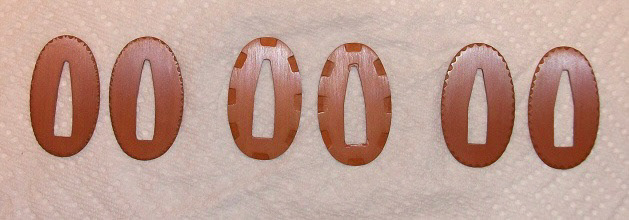
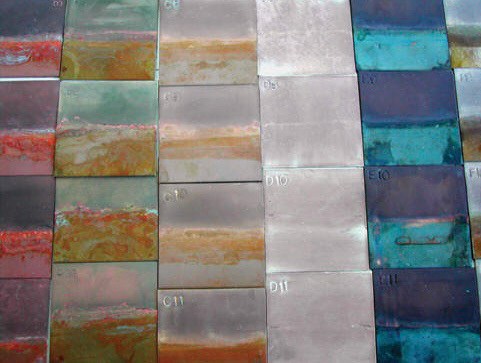
Getting Gallery Ready
There were several things I needed to prepare to get my pieces ready for display, which is what all of this is building up to. The first thing that was a major concern to me was the fact that I have some small vessels, that in a busy room, could easily get picked up by a copper thief. I considered having a clear epoxy box around the pieces but didn't like the idea of them being behind glass, where the lighting could mess up and ruin the display. So I started having a look at different museum gels and putties.
From what I gathered, museum wax and gels are ideal for translucent or glass objects where you don't want it to show through the piece. Museum putty however, is better for opaque objects and might be a better hold for heavier objects.
I found this quakehold on Amazon to test out on my pieces. I need to make sure that its hold is strong but also doesn't rip off patinas when removing.
Exhibition & Display Basics
I read this help sheet for gallery display techniques and these are the main points I took away from it:
- Avoid presenting objects less that 90cm or more than 200cm from floor level.
- 3 things to avoid: string, sticky tape and pins. they are unreliable and unsightly
- No exhibit should be placed in direct sunlight, close to radiators or near electrical equipment.
- Simplify exhibition area: be selective with objects on display- no necessary to have every item in your collection on display.
- Tell the story: does the display emphasise the most important aspects of the story or object? Does it grab you?
- Is the text easy to read?
- Does the spatial relationship between the items help the display?
- 3 things to avoid: string, sticky tape and pins. they are unreliable and unsightly
- No exhibit should be placed in direct sunlight, close to radiators or near electrical equipment.
- Simplify exhibition area: be selective with objects on display- no necessary to have every item in your collection on display.
- Tell the story: does the display emphasise the most important aspects of the story or object? Does it grab you?
- Is the text easy to read?
- Does the spatial relationship between the items help the display?
Practitioners similar to me
Rebecca, a metal smith based in Cornwall, makes copper vessels and boxes with different patinas. Her ‘concept of containment, domestic, ornamental or ceremonial has endless fascination for me.’ In her work, she used a combination of pewter and copper with no soldering involved in her processes; she uses stables, rivets and clasps to hold the pieces together.
I really resonated with the patinas that she uses. I recognise the salt, vinegar and ammonia patina, that shade of blue and the texture the salt leaves behind. I also love how organic her forms are and I can see my pieces sitting beside hers in a gallery.
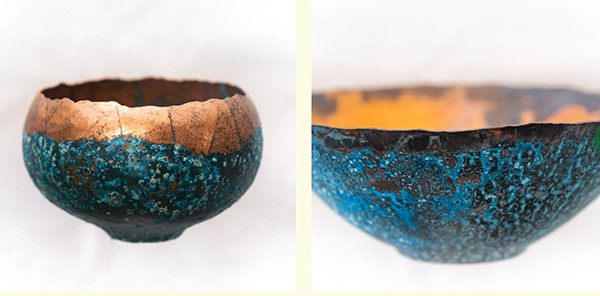
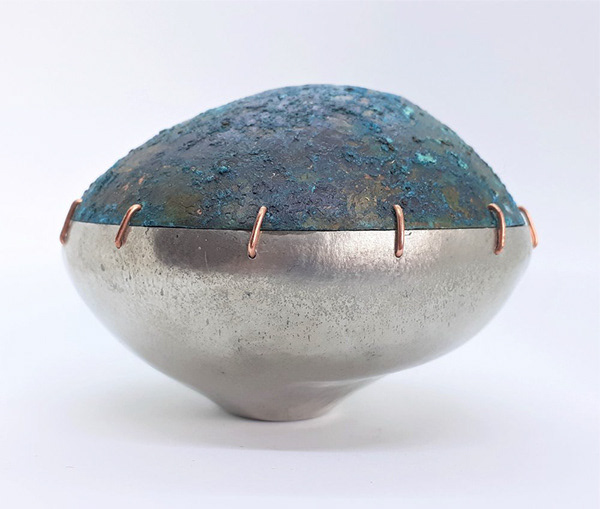
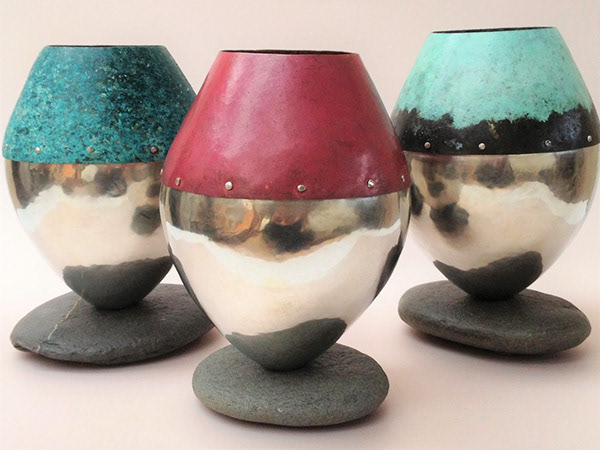
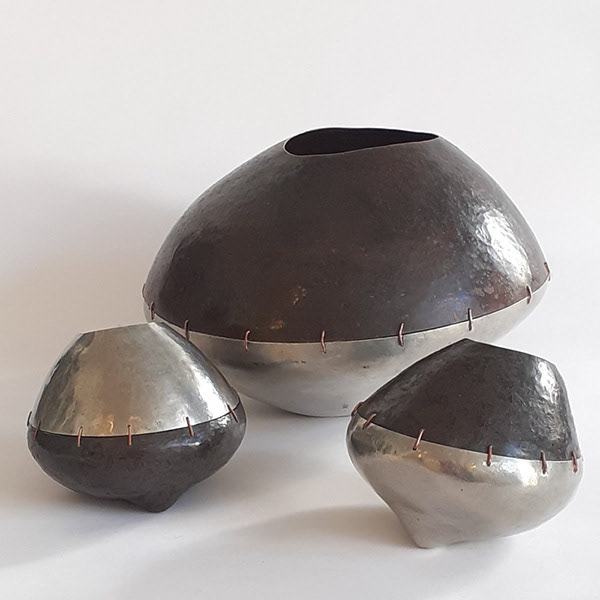

Jack Doherty is a ceramicist who’s studio is also in Cornwall and has evolved (or devolved) his practice into to working ‘with one clay body, one mineral and one single firing technique.’ He sees his pieces are figurative objects and explains that ‘anonymous and uncomplicated pots from pre history used for storage, cooking and protection can also function in other ways’. ‘He’s uses one clay, one coloring mineral and a single firing with soda’ his technique has simplified over time but has become more refined. The colour of his pots is achieved using copper.
I love the use of copper on these pots as it really resembles a patina the colours are striking and I really like the patchiness and the seaming lack of control.
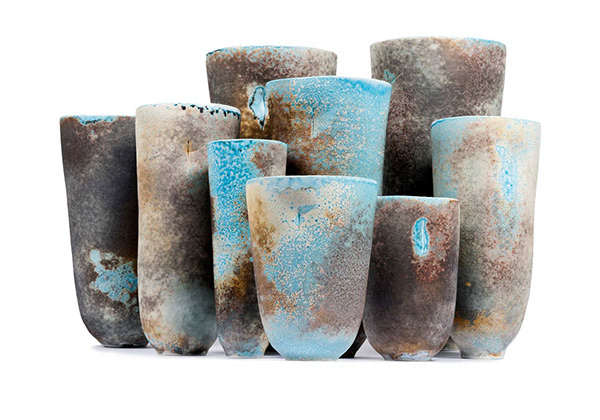
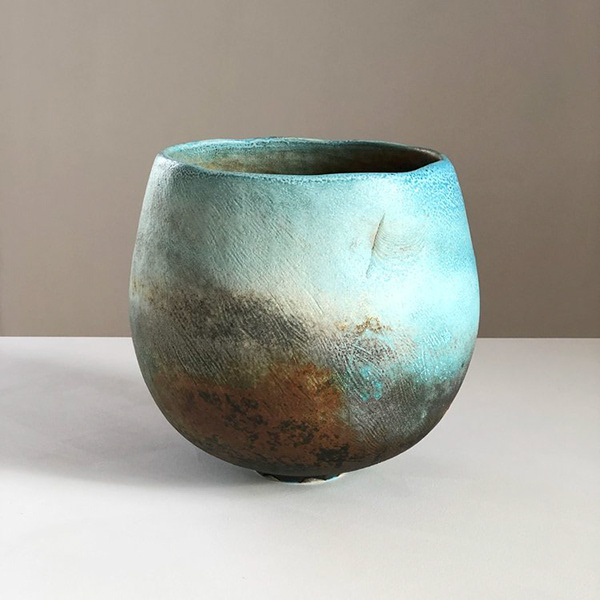
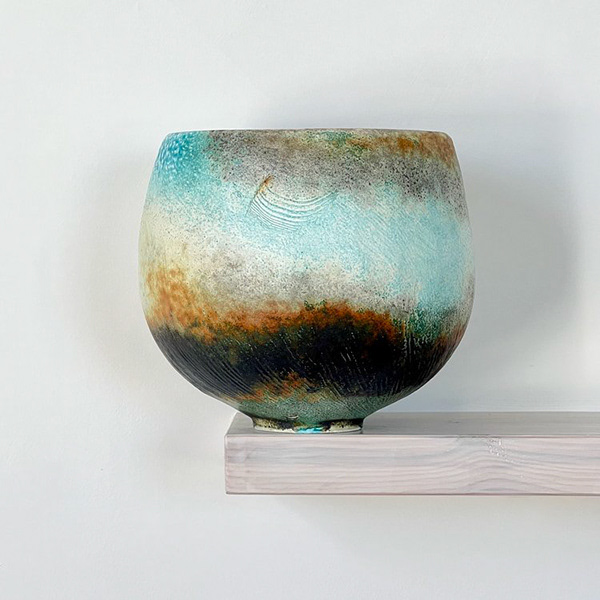

Adaesi’s work is a bit more sculptural than the other two but expresses fluidity through copper and brass. She uses hammers and steaks to form her sculptures from flat sheet and uses copper for its malleability and strength.
Although our work may be very different, we use very similar metal working techniques and have the same reason to use copper instead of other materials. It shows how diverse copper can be and depending on what perspective you look at it, can transform into very different objects.

